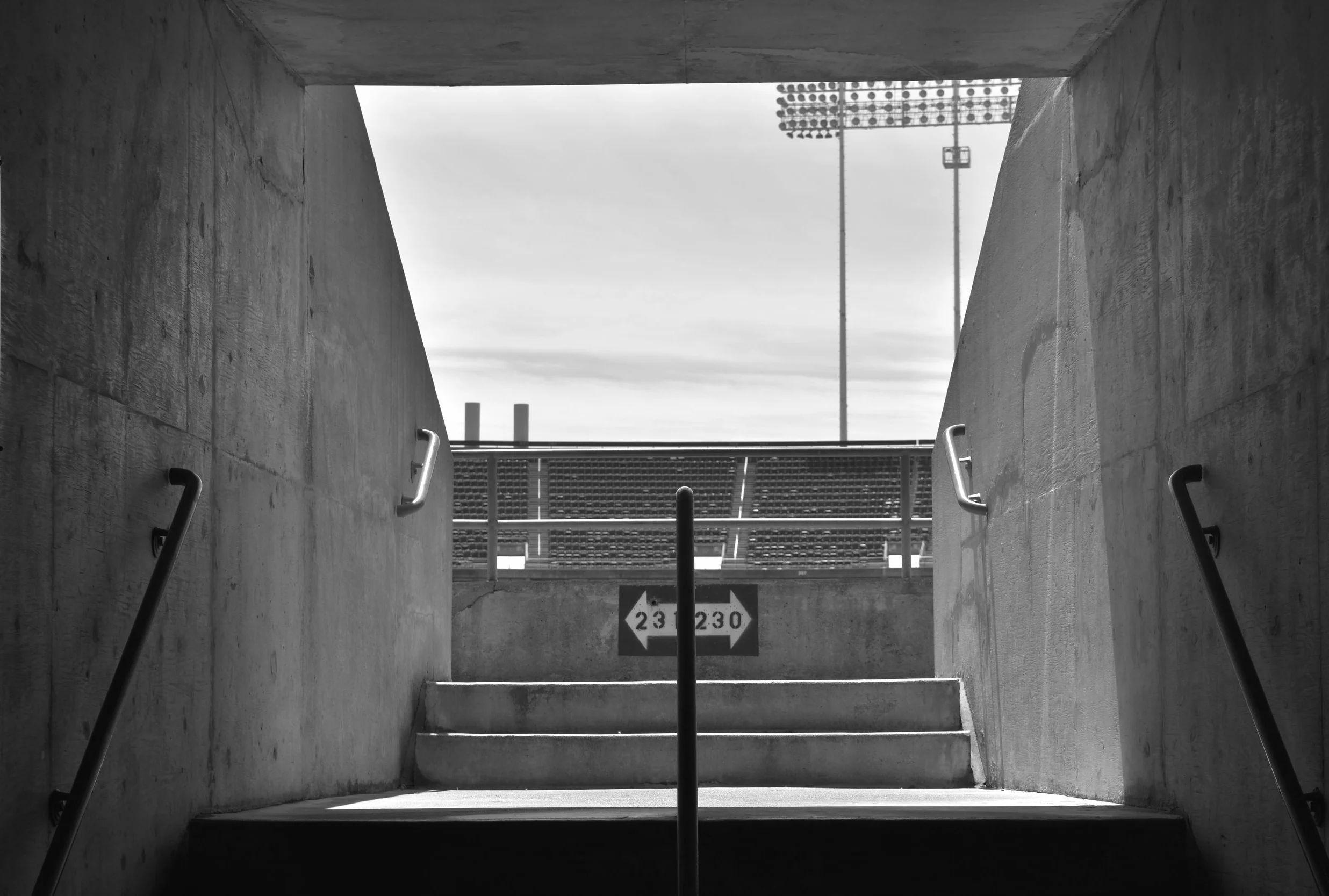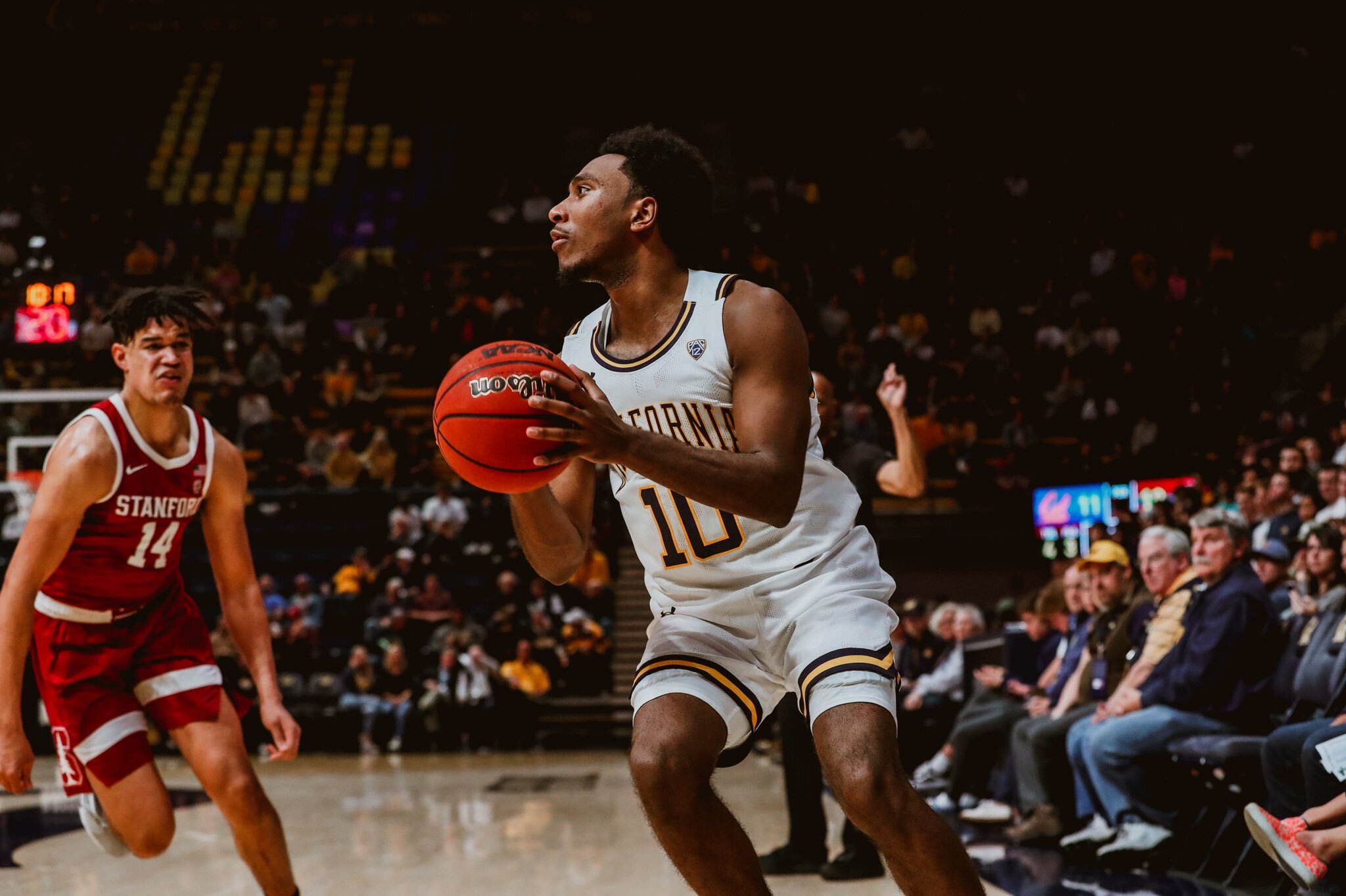“From Seaside to The Hilltop” - Jamaree Bouyea’s steady rise to stardom at the University of San Francisco
/Bouyea is leading the Dons in both points (17.2) and assists (3.8) in his fourth year at USF. (Photo by Connor Buestad - Section925)
By Connor Buestad | Connor@Section925.com
University of San Francisco’s Todd Golden couldn’t contain himself, and he didn’t care much to hide it. The 35-year-old had just secured his signature win as a college head coach, in just his second year at the helm of a Division 1 program. He had beaten defending national champion Virginia and ACC royalty Tony Bennett, at a neutral site, in front of a national ESPN audience. College baskekball fans were nursing a collective 2020 Thanksgiving hangover and thirsty for a feel-good moment.
After conducting a calm and clichéd zoom call with media members discussing the biggest upset of the young college hoops season, Golden busted through the door of the Dons’ locker room, skyed for a mid-air first pump/leg kick and barreled into his players, setting off an onslaught of chest bumps, bear hugs and roars of raw jubilation. One of the few players not filming the celebration on their iPhone quickly found a bucket of water to douse their coach with. By night’s end, the scene had gone viral, airing on loop during that night’s episodes of SportsCenter.
The only person that somehow kept this cool in that crazed USF locker room after beating UVA that day was senior point guard Jamaree Bouyea. His #1 jersey already removed, with a towel around his neck and his trusted Kobe’s on his feet, Bouyea was seemingly in a zen state the entire time, seated with two feet flat on the floor in the corner of the room. His head bowed and his face grinning with contentment, Bouyea couldn’t help but sit and contemplate the long road that got him to that moment and wonder quietly what was about to come next.
“To tell you the truth I wasn’t too surprised when I saw all that,” explains Bouyea’s notoriously supportive mom, Janine. “It’s been that way since he was little. He’s always been focused on what’s next in life, and how he’s going to get there. That’s just kind of been his style.”
--
After starting a total of 11 games in his first two seasons at USF, Bouyea is now leading the Dons in minutes played for the second straight year. (Photo courtesy of USF Dons Athletics - Christina Leung)
It’s no exaggeration to say that nothing has been given to Bouyea over the course of his basketball journey, only earned. In his most recent trip to play at top ranked Gonzaga inside an empty Kennel in Spokane, the announcing crew wondered aloud how and why Bouyea only received one D1 scholarship offer out of Palma High School in Salinas, as he dropped 16 first-half points against heralded freshman Jalen Suggs, a consensus NBA lottery pick for 2021. The suspicions grew with every buttery pull-up three pointer, every calculated slice through the lane, every thoughtful set-up pass to an unsuspecting teammate for an easy bucket. “How do you pass up on such a complete player like this?” they kept asking.
To his credit, Jason Hieb knew all along that “Jamaree was just special.” When you talk to Hieb, the head of Seaside’s Finest AAU basketball program on the Monterey Peninsula, he uses the term special when describing Bouyea at an alarming rate. The word is used constantly when he tries to describe the quiet kid from Seaside that put his basketball program on the map for good. Other adjectives pop up during the course of conversation, yes. But eventually, Hieb will give up and say “I don’t know what to tell you man, the kid is just special. That’s the best way I can describe it.”
Jamaree was just 3-years-old when he first met Hieb inside Seaside High School’s gym. Hieb was busy coaching Jamaree’s older brother Jonquis, who was the star guard on Hieb’s under-8 Seaside team, alongside Hieb’s own son Kyle of the same age. As Hieb tried and failed to convince a group of 7-year-olds to pass and screen away on offense and maybe come to a two-foot jump stop once in a while, he couldn’t help but notice the toddler on the sideline, laser focused on what was happening on the court out in front of him. “He would just watch, man. Watch for hours. One of the most focused and observant kids I’ve seen walk into my gym. Eventually we gave him a ball to bounce around on the sideline, but even after that he would spend a lot of time watching the older kids, just learning on his own. For a kid that young, it was kinda special, to be honest.”
Growing up in a household that included his father Stan, eldest brother Keevin and his middle brother Jonquis, Jamaree developed a passion for sports at a very young age. Whether it be baseball, soccer, or basketball; you name it, if it was happening, Jamaree was desperate to be involved and emulate his older brothers. “I remember I had this old beat up truck at the time,” explains Hieb. “There was really no room for Jamaree, but he insisted that we let him lay down on the floor of the truck if I was ever driving to a game. He could care less if there was a seat for him. He was just always around, no matter what.”
By the time Jamaree was in middle school, basketball became his main focus, as his dream to play college basketball began to crystalize. His entire weekends were spent solely at the Monterey Sports Center, where his mom bought him a membership. “I never really saw him on the weekends during those years, he was just always there playing basketball with his friends,” says Janine.
When he wasn’t at the Sports Center, Jamaree was with Coach Jason at an AAU tournament somewhere across the western United States. Jonquis, who later played at Cal State Monterey Bay, had helped pave the way and set the tone for the Seaside’s Finest program, but Jamaree was waiting in the wings to take it to a whole new level. “Jamaree was always a bit shy, always kind of a nice kid who didn’t want to step on anyone’s toes in my program. For instance, he didn’t necessarily want to play up in age group, he was always willing to wait his turn, wait for his time to shine,” says Hieb. Eventually, that time arrived.
Traditionally relegated to the back courts of the prestigious AAU tournaments of L.A., Georgia and Las Vegas, with Bouyea as his point guard and the requisite clout under his belt as a coach, Hieb started to demand prime time slots for his Seaside’s Finest team. It was time to play the best players from around the country, in front of the big time coaches, no matter the results. “I got us in these games we might have had no business being in. Jamaree would be getting pressed by some of the best teams in the county and he would just look at me sweating it out and say ‘I got you coach’ and just take care of it. He always had a way of taking control of a chaotic situation in a cool manner,” remembers Hieb.
--
Like his older brother Jonquis, Jamaree spent countless hours playing for his local AAU team, Seaside’s Finest. (Photo courtesy of Seaside’s Finest)
Despite years under his belt putting Seaside’s Finest on the map at the time and Hieb’s role as JV coach at Seaside High School, when it came time to pick a high school to attend, the choice was solely Jamaree’s. After much deliberation, Bouyea chose to be the first member of his family to attend Palma High School, a private school in Salinas, known in the county for its athletic excellence and its varsity basketball coach at the time, Paul Alioto. “It was really tough to leave all my middle school friends and go to Palma, but I knew this was my best shot to make college basketball happen for myself, so I took the opportunity and tried to make the most of it,” said Bouyea.
After arriving on campus as a freshman, Bouyea was still largely undersized and still in dire need of a serious growth spurt if his dreams of D1 basketball had any hope of working out. After tryouts, Jamaree was relegated to the freshman team, deemed not even good enough for a 6th man role on the JV’s. Moreover, the freshman team implemented an “everyone plays” type rotation where Jamaree’s starting group had just five minutes on the court before the next substitution cycle. The slice of humble pie was larger than Jamaree could have expected.
Still, his calm and poised demeanor prevailed and Bouyea sought out every opportunity to prove himself and capitalized on it. During a holiday tournament as a freshman, his coach half-jokingly guaranteed the team a free meal at Foster’s Freeze if the team won the championship. Jamaree went ahead and won it. By January of his freshman year, he was finally bumped up to JV and his new team never lost a game for the rest of the season. Still, the year ended on a bittersweet note, as coach Alioto announced he was leaving the school at the end of the year.
Alioto was replaced by Kelley Lopez and the Bouyea family welcomed him with open arms. In his first three years with the program, Lopez and Bouyea teamed up to go 76-16, never losing a league game in three years, twice making the NorCal Finals and once making the State Championship game at Arco Arena in Sacramento as a junior, only to fall short to Duke’s Cassius Stanley of Harvard-Westlake in Los Angeles.
Even while compiling one of the greatest high school basketball careers in Palma HS history and starring for Seaside’s Finest formidable AAU program, the D1 offers didn’t exactly start pouring in for Bouyea as he put together league MVP seasons and runs to the state title game in the capital. In fact, not one offer came in. “To be honest, I can’t tell you exactly why,” says Bouyea, days after his 18-point performance at Gonzaga. “When I would go to summer camps at places like Stanford and UOP, I would just kind of play my role on the team. Everyone would tell me to try to take over more and score as much as possible, but that just wasn’t my style as a point guard.”
By the time Bouyea’s senior year of school rolled around, Hieb started to wonder if it was too late to be thinking D1 any longer. “There’s a certain point where you just need to go where you are wanted. You can’t wait forever,” he explained.
It was the eleventh hour of the recruiting process when the USF coach at the time, Kyle Smith, invited Jamaree to the Hilltop to take an official recruiting visit. Smith had coached Palma graduate E.J. Rowland during his days as an assistant at Saint Mary’s College and figured Bouyea could be built from the same mold, so he took a flyer on a player so many others didn’t even bother to look at. Less than a week later, Jamaree interrupted one of his pickup games at the Monterey Sports Center to take a cell phone call from a number he had recently saved in his phone. It was Coach Smith, offering Jamaree his only D1 scholarship. The answer was an immediate “YES,” followed by a call to his parents, then finally a return to his pickup game with his friends to finish what he had started.
--
In three varsity years at Palma High School in Salinas, Bouyea never lost a league game. (photo by Ted Walker - MaxPeps.com)
Much like in high school, Bouyea arrived as a freshman on campus in San Francisco ready to play for an accomplished coach, with hopes of being an impact player, catapulting him to a new level of basketball. But just as was the case at Palma, Bouyea found himself at the fork of a longer road than he had imagined. While the elite freshmen of his class around the country were starting right away, getting almost all the shots they wanted and counting down the days to NBA pre-draft workouts, Bouyea was relegated to the bench on a middle-of-the-pack WCC team. He only averaged 2 points and 13 minutes played per game, stuck behind his freshman roommate Souley Boum from Oakland Tech HS as well as star junior PG Frankie Ferrari. By the end of the year the Dons were 9-9 in league play and Boum had decided to transfer out of USF. His best friend on campus was gone.
After a sophomore year in which Bouyea mustered just 6 points per game as a backup, the one major college basketball coach who gave him a scholarship offer was headed out the door as well, headed for a job in the Pac-12. Still, Bouyea never thought about leaving himself. “USF was the first school to believe in me and I knew if I kept improving every year I could become a starter here. I knew Coach Golden would run a similar program to Coach Smith. It didn’t make much sense to me to start over somewhere else where the coaches didn’t know me,” said Bouyea.
--
Bouyea’s assist/turnover ratio as a senior is 1.5, while Gonzaga’s Jalen Suggs has a 1.6. (photo courtesy of USF Dons Athletics - Christina Leung)
Now in his senior year as a Don, Bouyea is the face of a program that is on the rise, in a conference that has never been better, averaging a team-high 17 points a game. Sadly, players like him in college basketball are nearly extinct. As much as Bill Walton, Dick Vitale and Jay Bilas would hate to admit it, the 4-year senior who stays at the same school, getting better every year and improving himself into an all-league player is no longer the rule, but rather the exception. And with a new ruling stemming from Covid-19, Bouyea even has a free fifth year of eligibility on the table at USF waiting for him if he wants it. In so many ways, he’s the last of a dying breed of basketball players: one AAU program, one high school, one college, all for four (maybe five) years.
You won’t find Bouyea on any NBA mock-draft boards, but you didn’t see Matthew Dellavedova or Patty Mills on many draft boards either and they’ve each cut out long NBA careers for themselves after shaping their skills in WCC gyms such as War Memorial in SF. Even the prospect of playing overseas is something few thought possible for Bouyea when he struggled to get a sniff from college coaches coming up through the ranks. His most valuable skill might be finding out what’s next and figuring out how he’s going to get there.
--
USF has been to three Final Four’s, but it’s been 23 years since the Dons last went dancing. (photo courtesy of USF Dons Athletics - Christina Leung)
Despite 16 appearances in the NCAA Tournament and two National Championship titles in the 1950’s led by K.C. Jones and Bill Russell, San Francisco hasn’t been to the Big Dance since 1998. They find themselves in a precarious position. In a league that is rarely granted more than two tournament bids, Gonzaga and their current #1 national ranking always takes one bid, leaving BYU, Saint Mary’s and the rest to scramble for seconds. For the fourth straight year, Bouyea finds himself on a team trying to keep tournament hopes alive in a league filled with elite recruits from both stateside and around the world. Despite the odds, Bouyea’s trusted youth coach still believes he can somehow sneak the Dons back into a March Madness bracket before his time on The Hilltop is complete.
“It obviously would be really special for our program if we could get back into the tournament after all these years,” says Bouyea as he discusses the ups and downs of his basketball career. “I remember being driven to the Sacramento Kings arena when I was in 8th grade I think. There weren’t too many people in the stands, but Mater Dei was playing for the state title with Stanley Johnson. It was an awesome atmosphere. I remember Coach Jason (Hieb) gave me some popcorn to share and I just sat there staring at the game, watching Stanley, hoping one day I’d play in games like that. I ended up eating the entire thing of popcorn by myself,” he explains with a smile. “Yeah,” he continues. “I definitely still owe Jason a whole bucket of popcorn to this day.”
Bouyea skies for a dunk in recent game at War Memorial Gym in San Francisco. (photo courtesy of USF Dons Athletics - Christina Leung)
E-mail section925: connor@section925.com
San Jose State's wild season will conclude on NYE 2020 with Nick Starkel behind the wheel
/SJSU QB Nick Starkel will be a sixth-year-senior in 2021. (photo by Neville E. Guard)
By Connor Buestad | Connor@Section925.com
San Jose State football might be the most 2020 team ever.
With their shortened season not starting until October 24th, the Spartans weren’t allowed to practice on or around their campus due to Coronavirus, so they set up shop in Humboldt County for their training camp. The Humboldt prep paid off immediately as the Spartans began the year with a win over Air Force and never looked back. Playing in a talented Mountain West Conference that they’ve never won, SJSU went 7-0 on the year with notable wins over Hawaii, Nevada and Boise State. Their last two “home” games on their schedule were played in Honolulu and Las Vegas, as they continued to follow state and local pandemic guidelines.
For their Arizona Bowl matchup with Ball State, however, San Jose State has decided to politely ignore Santa Clara County’s ten day quarantine policy and fly to Tucson in time for their New Year’s Eve matchup. The Spartans won the Mountain West Championship game on December 19th in Vegas and could have stayed in Nevada, but they elected to come back home to San Jose so the players could see their families for Christmas. Less than ten days later, they were back in a plane headed to Arizona. County Executive Dr. Jeff Smith told the Mercury News, “We can’t stop them.”
After finishing 1-11 in 2018 under current head coach Brent Brennan, the born again Spartans will be looking to complete their first undefeated season since 1939 on Thursday. They will be led by journeyman quarterback Nick Starkel, who has been in college for five years already and is completing his fourth year on the field. Somehow, he will be back yet again next year, as the NCAA has granted all 2020 players an extra year of eligibility. Anytime you can go to college for six years and play QB the whole time, you have to do it, right?
College Football might be tired of me, but I’m not tired of College Football! pic.twitter.com/aNlvspqTk8
— Nicholas Starkel (@NickStarkel) December 29, 2020
Growing up in a military household, Starkel moved around a bunch as a kid until finally settling in to Texas life during his high school years where he made a name for himself as a big time recruit with heavy interest from SEC schools. But once Starkel reached his first college campus, he adopted his father’s transient ways quite quickly. After completing 138 passes over the course of two years playing for Texas A&M, Starkel found himself with a new coach and a new role as backup QB, so he wasted no time moving on to find a home as a starter. That led him to Fayetteville to play for the Hogs of Arkansas where he played eight games and experienced a nightmare season. Arkansas finished 2-10 in 2019, which included a home loss to San Jose State no less. Starkel threw more interceptions than he did touchdown passes, but Coach Brennan still saw some potential in him. If he ever got tired of the SEC, the MWC was always waiting.
Starkel took Brennan up on his offer and pulled the trigger on his third college in as many years and it couldn’t have turned out any better. While running an offense he’s only known for a few months, Starkel has reeled off 16 touchdowns in this shortened seasoned while throwing just four interceptions. Even with a prototypical NFL frame of 6’3”, 215 and a big arm to match, Starkel apparently can’t resist the chance to spend one more year on campus. Picture it now, the year is 2021, the Pandemic is in the rear view and College Gameday is set up under a palm tree on the SJSU campus. Indoor dining is legal and encouraged. Second year Senior Nick Starkel is being interviewed by Kirk Herbstreit on national television. Surely, stranger things have happened.
The Van Wilder comparison is uncanny. (Photo by Joe Scarnici)
(Photos) Cal upsets Oregon for their first win of 2020
/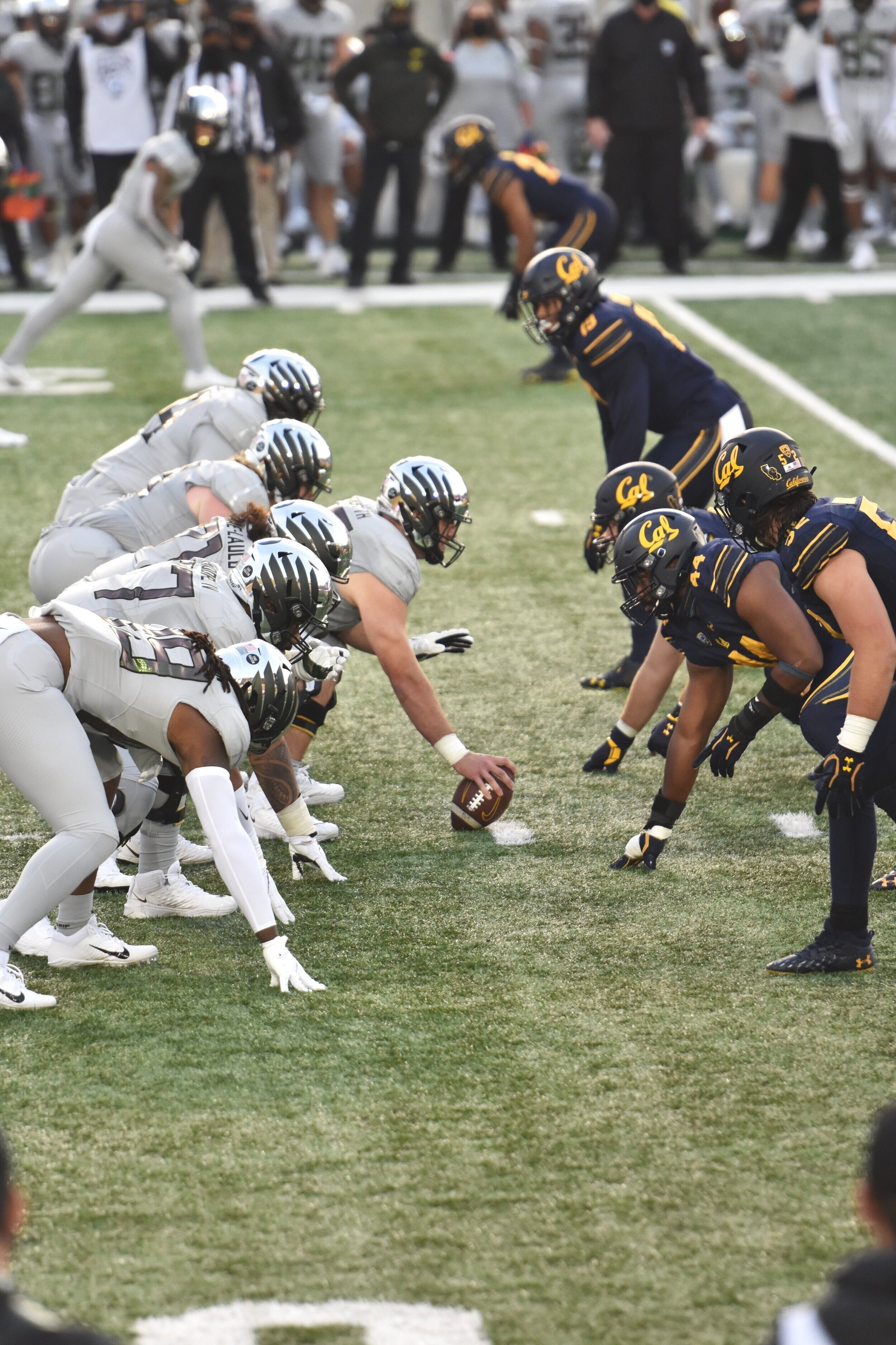

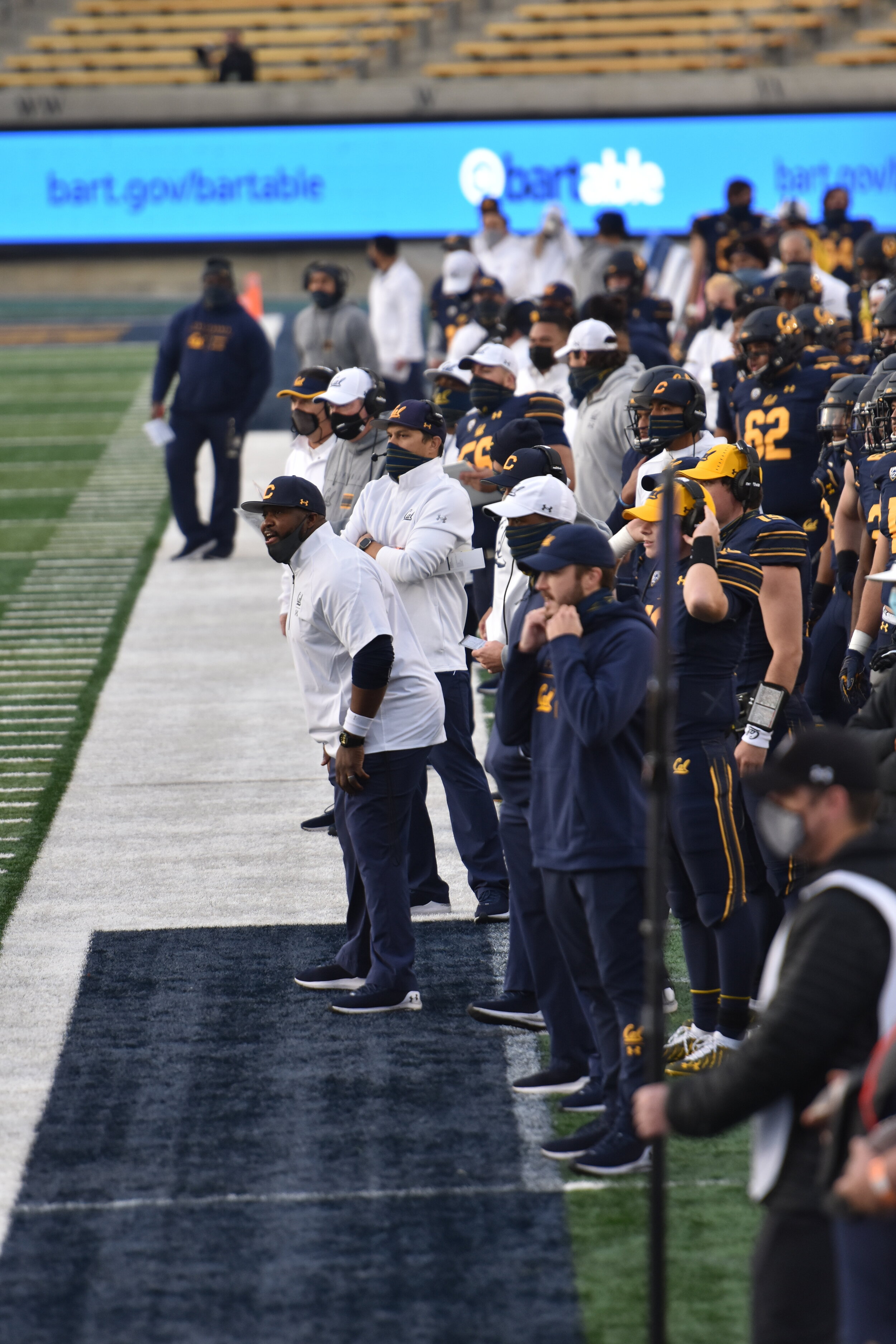
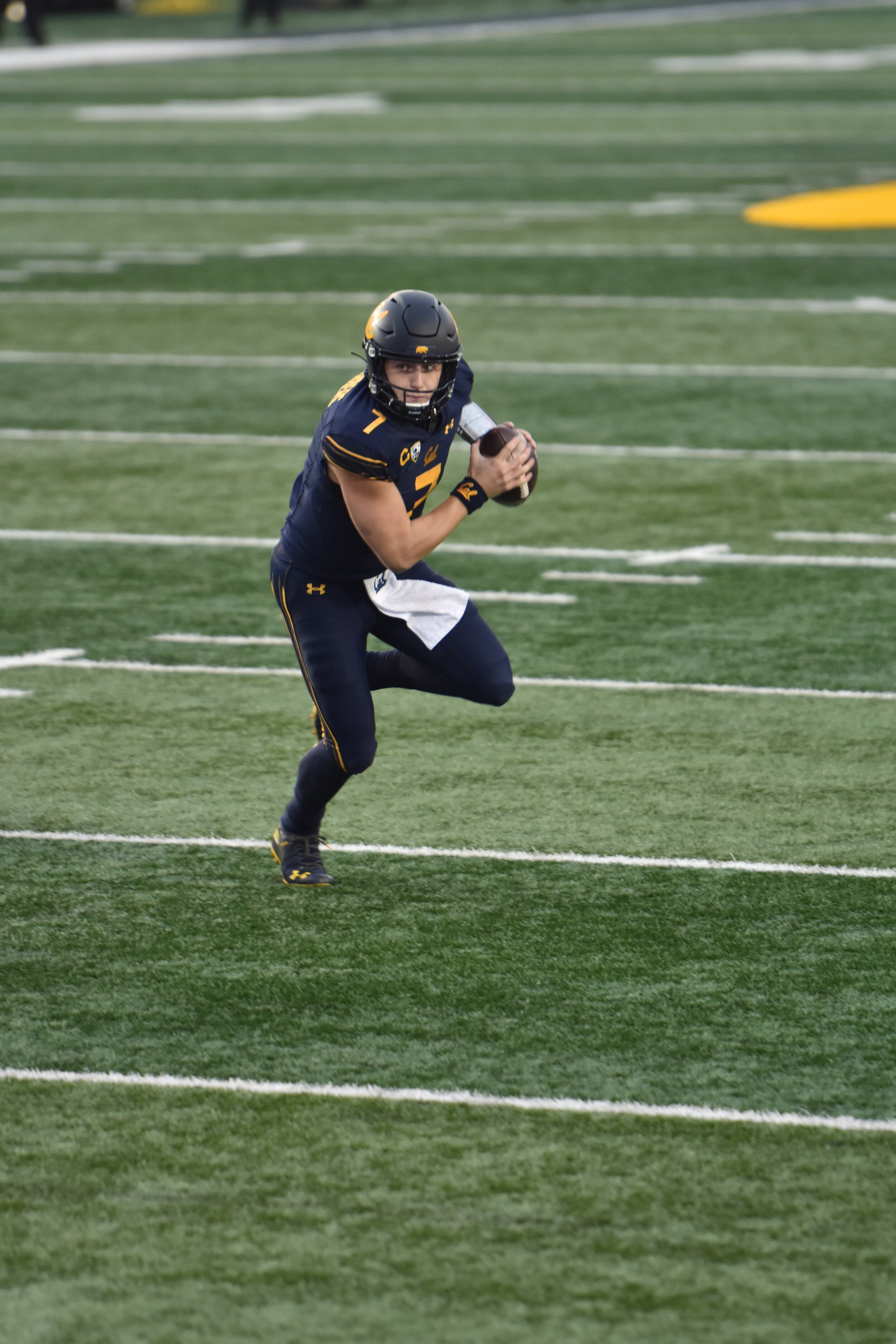
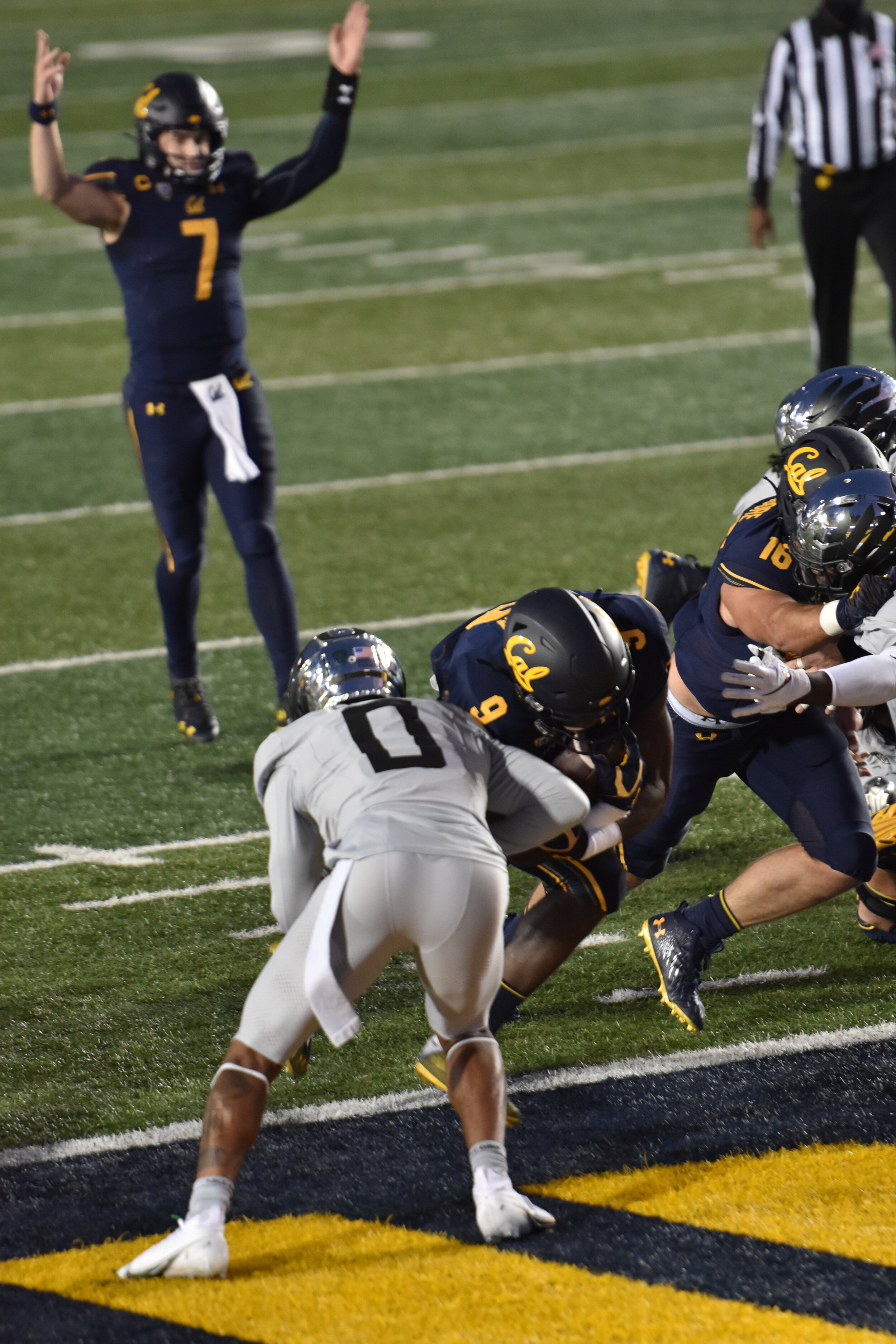
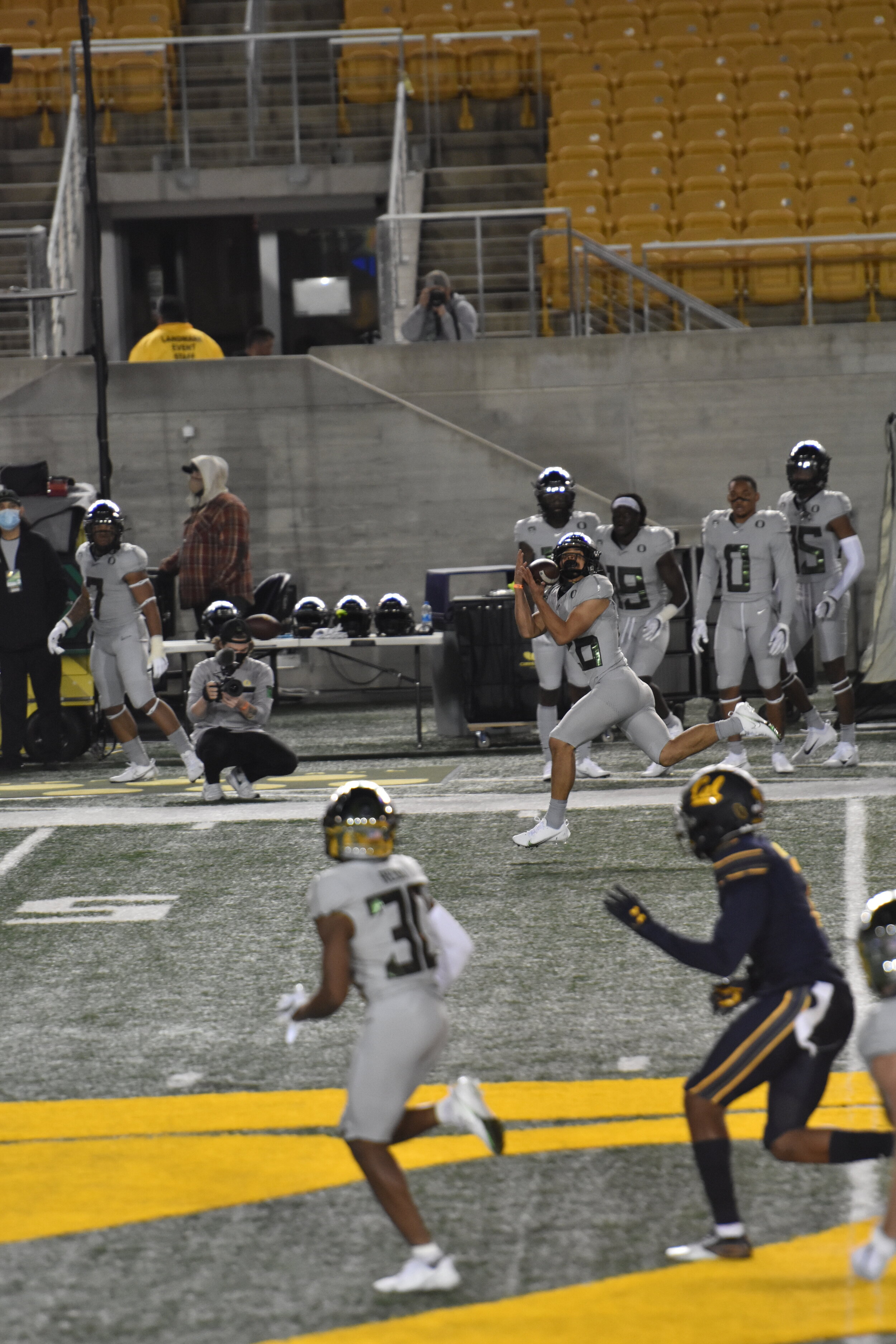
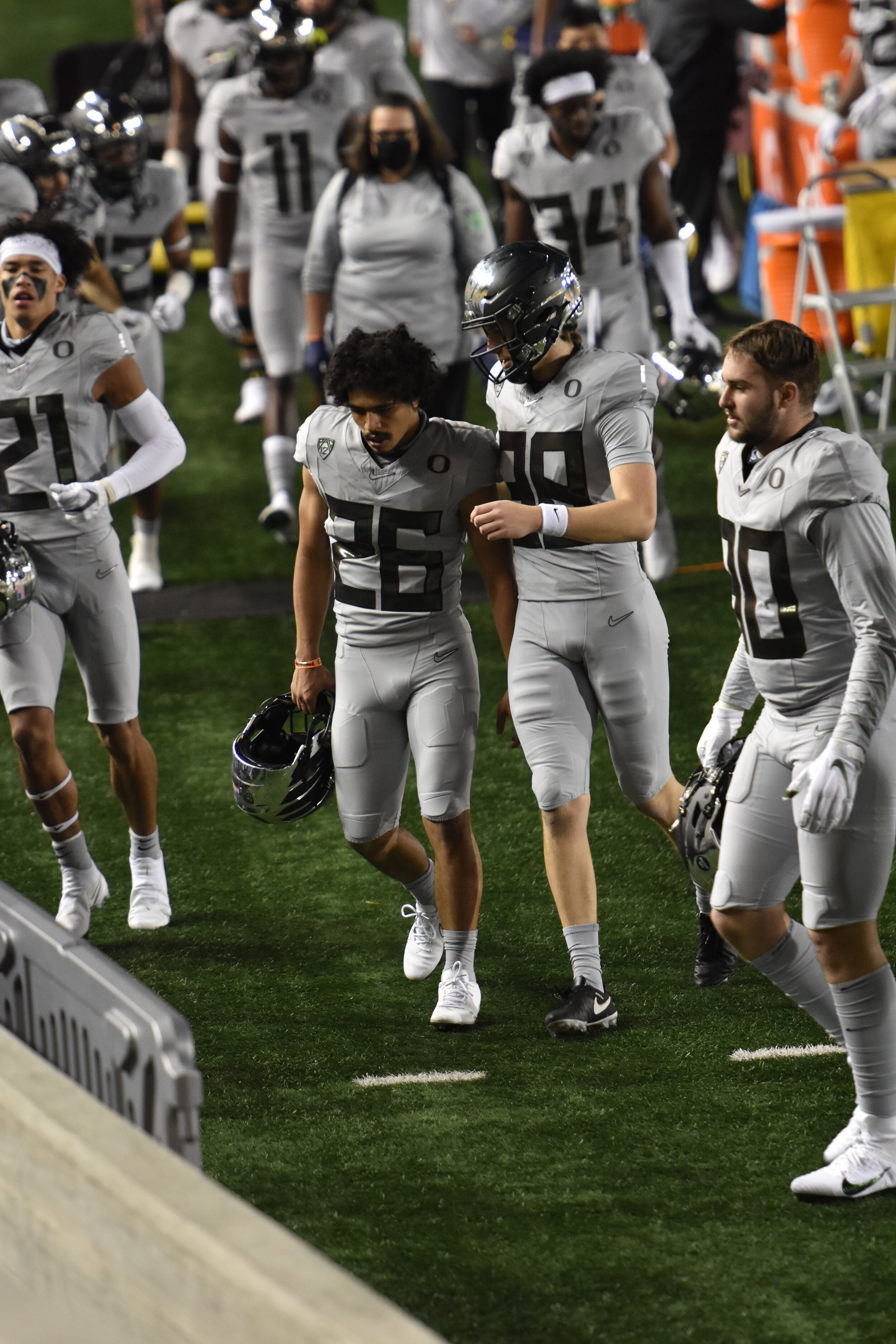
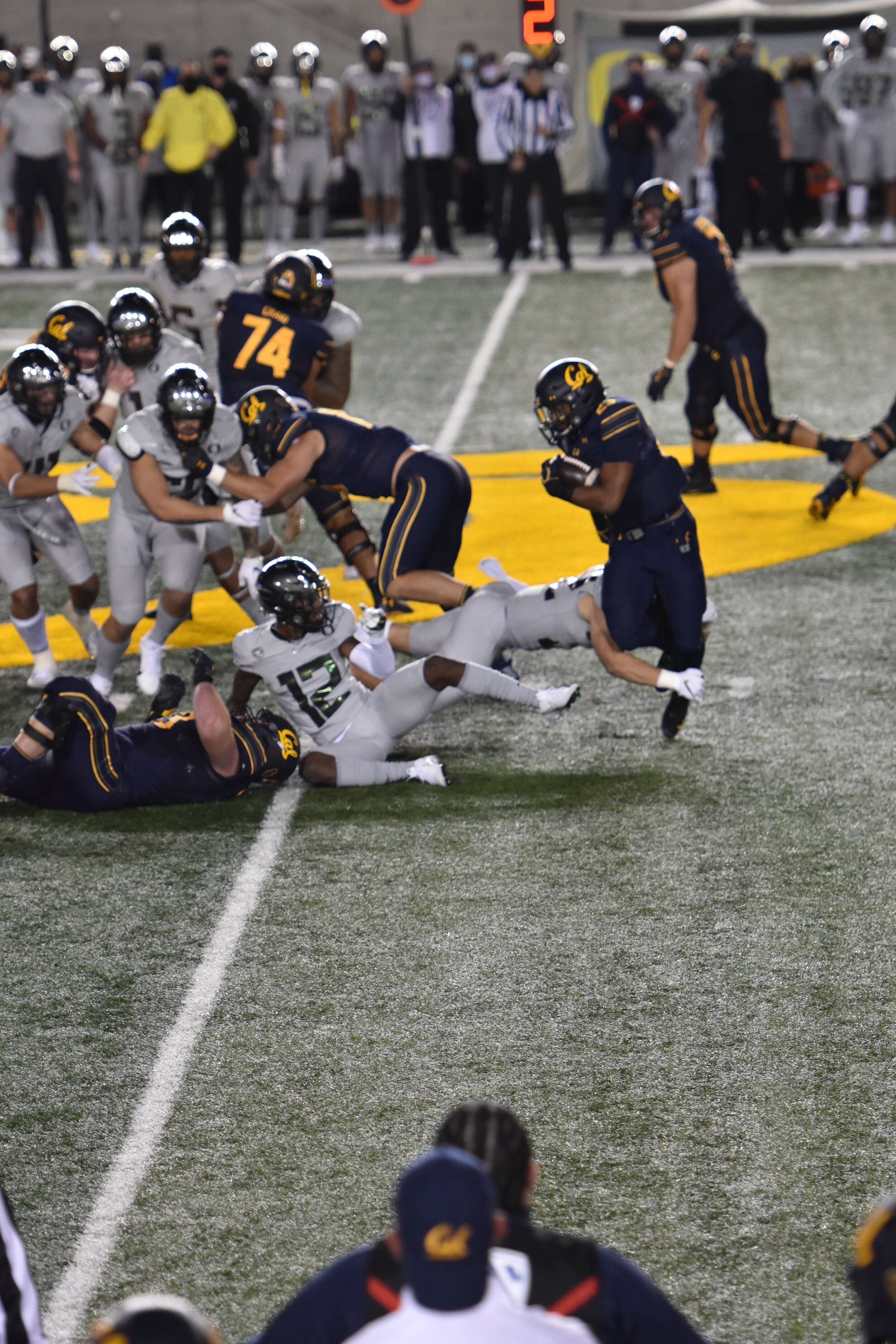
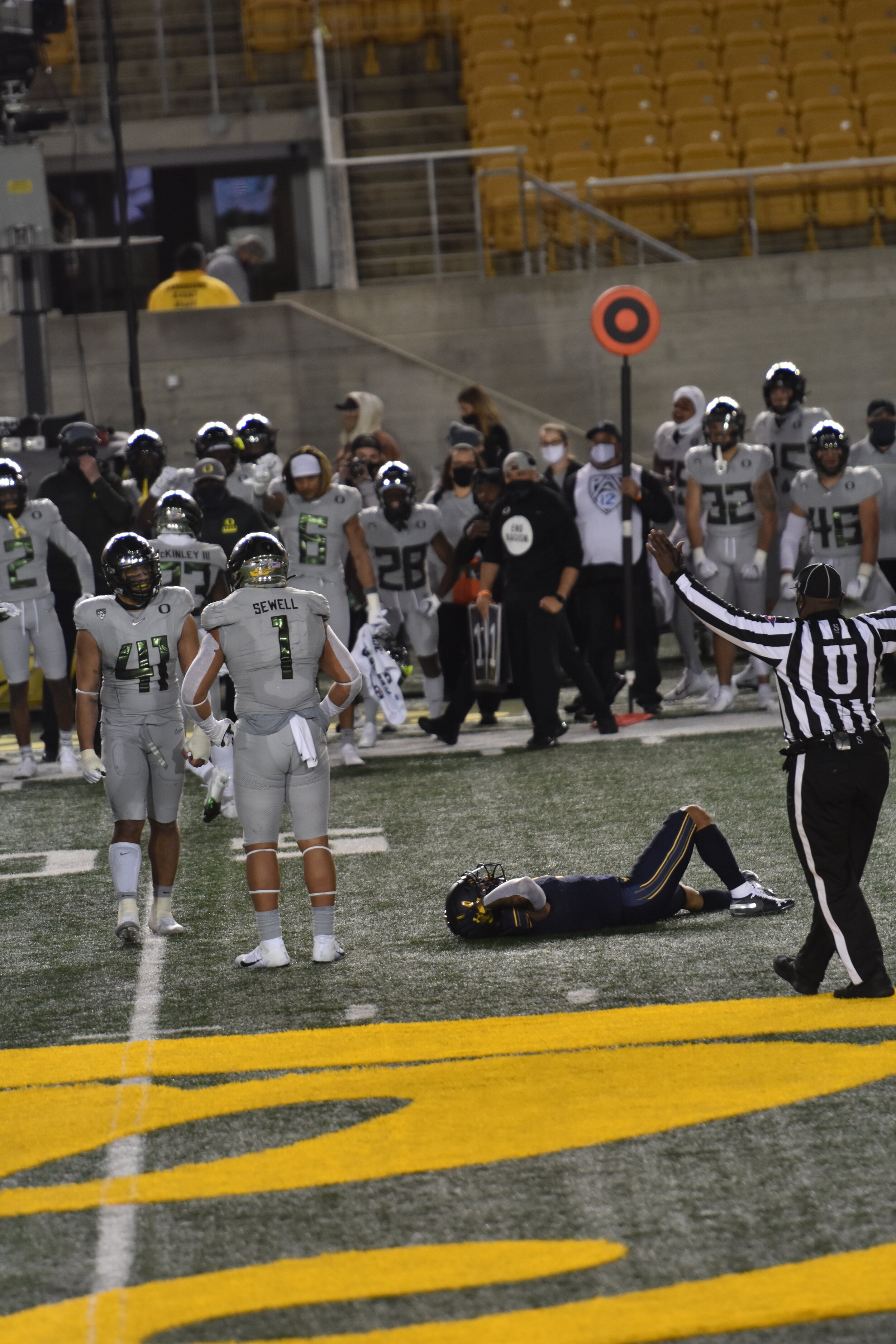
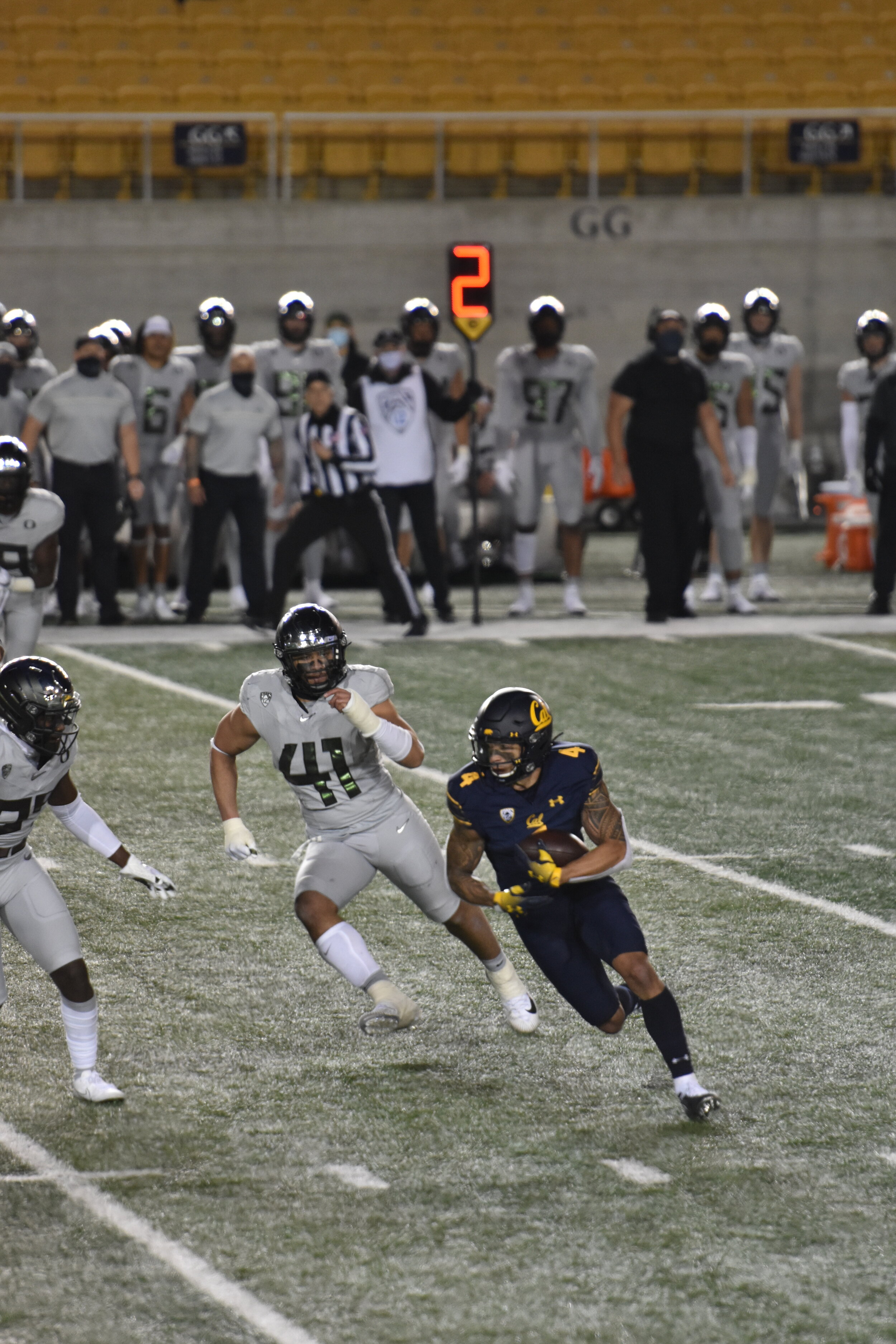
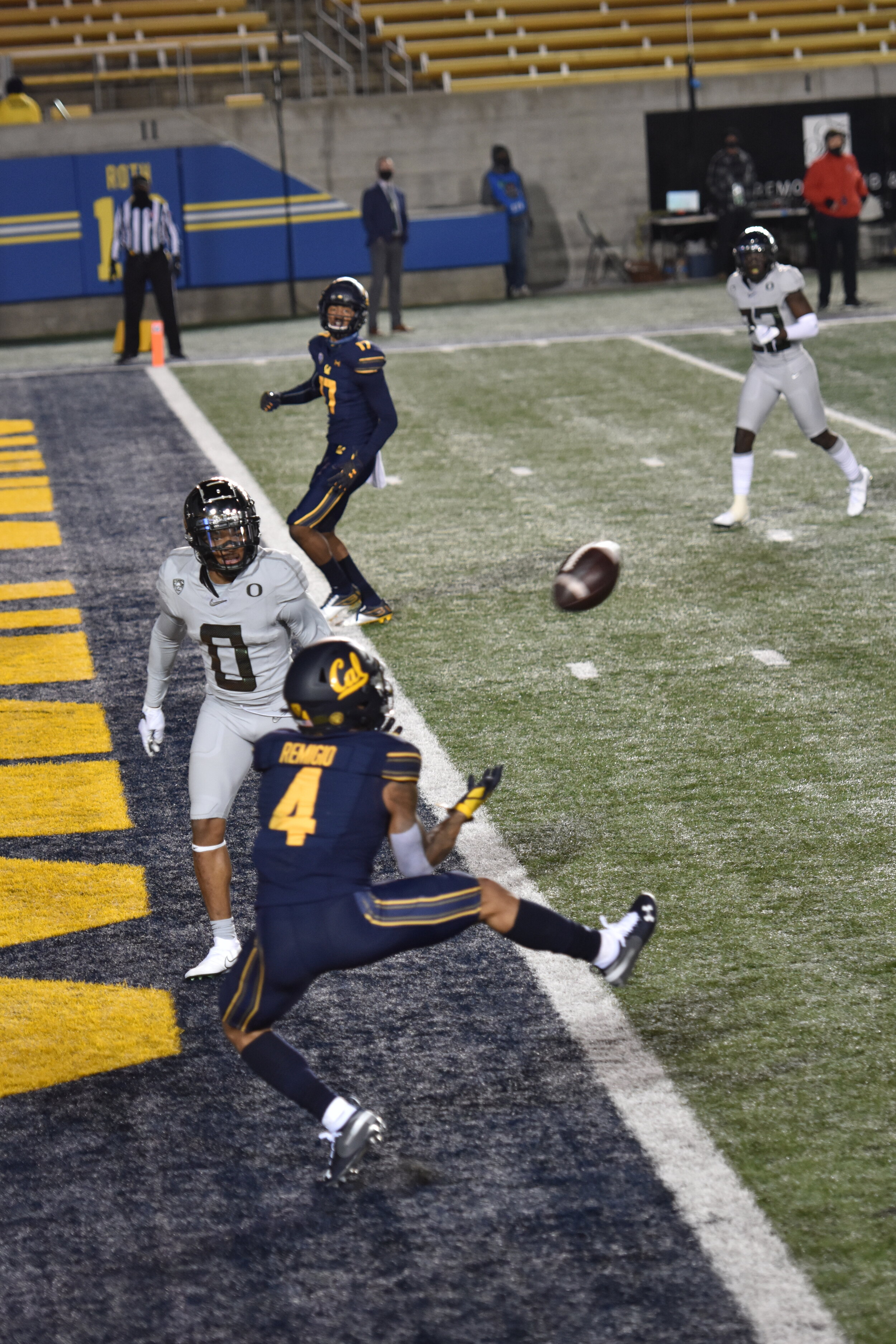


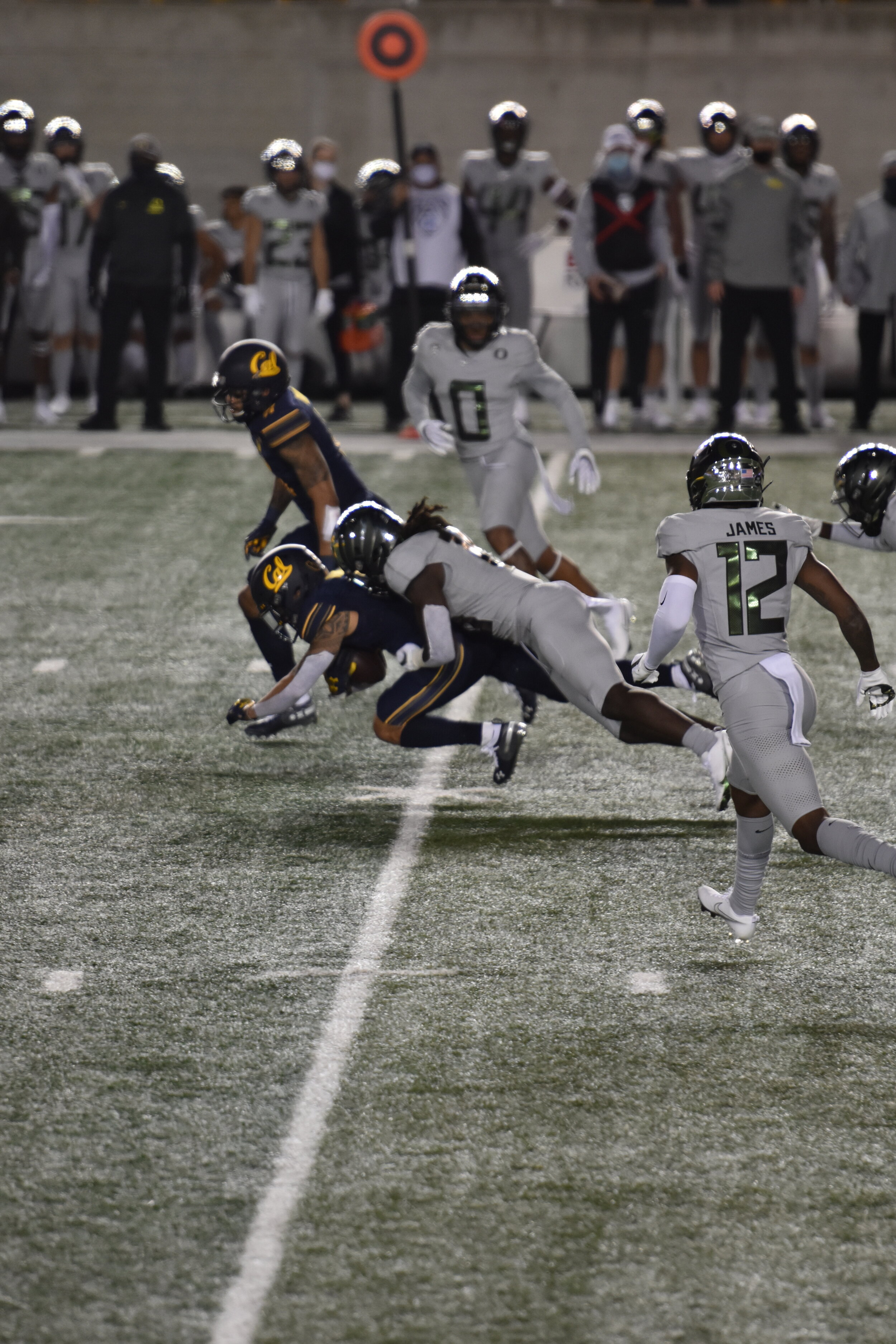
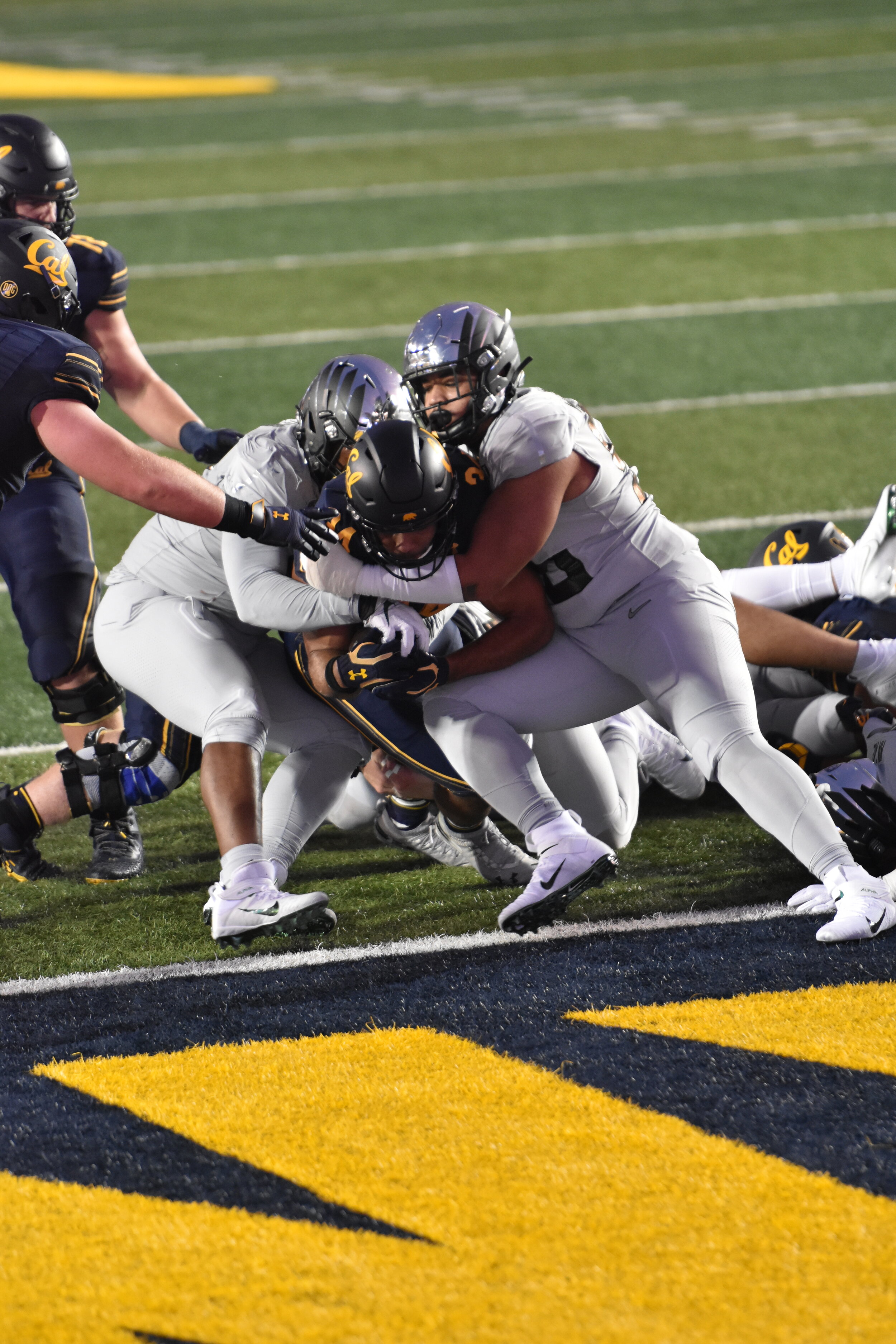

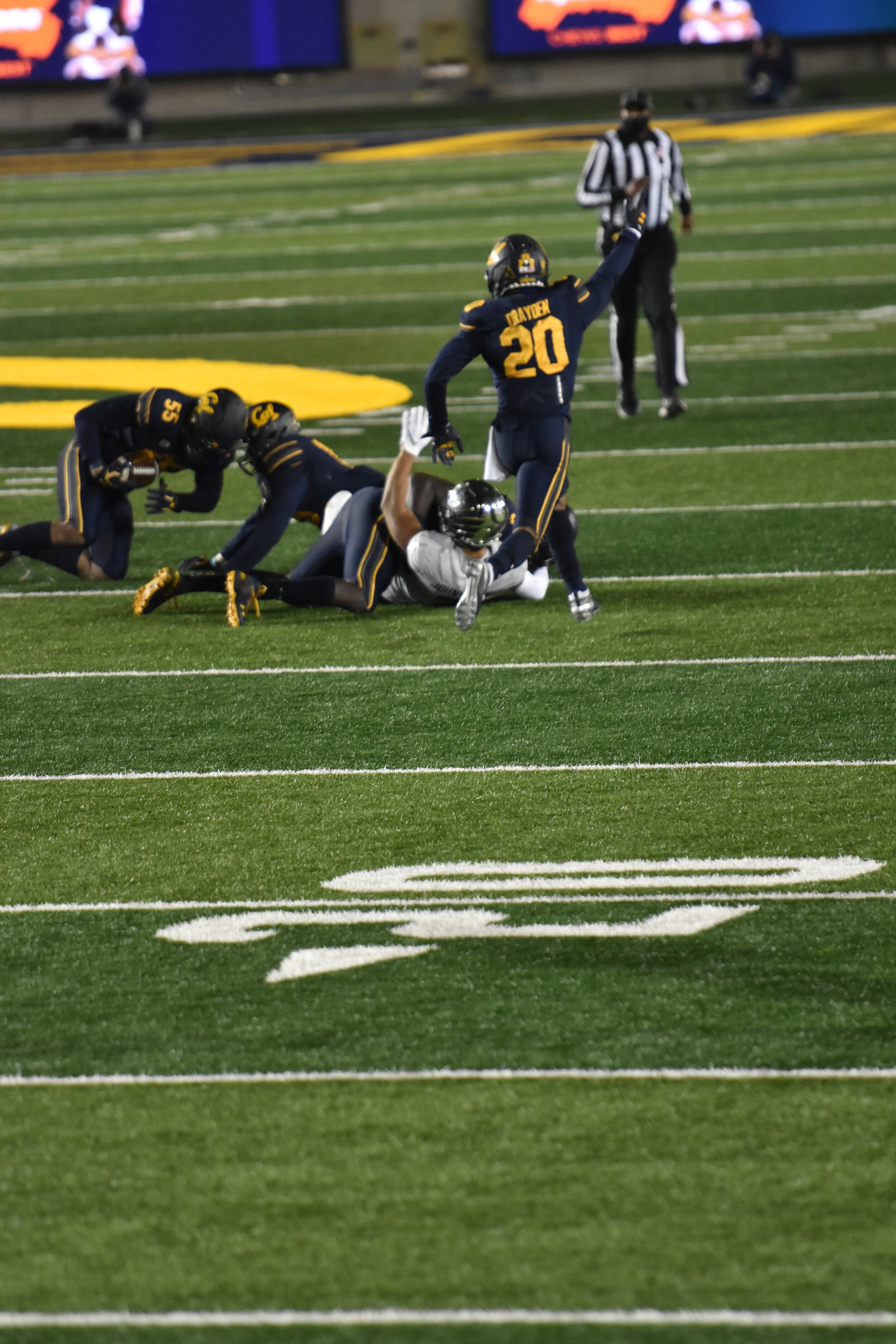
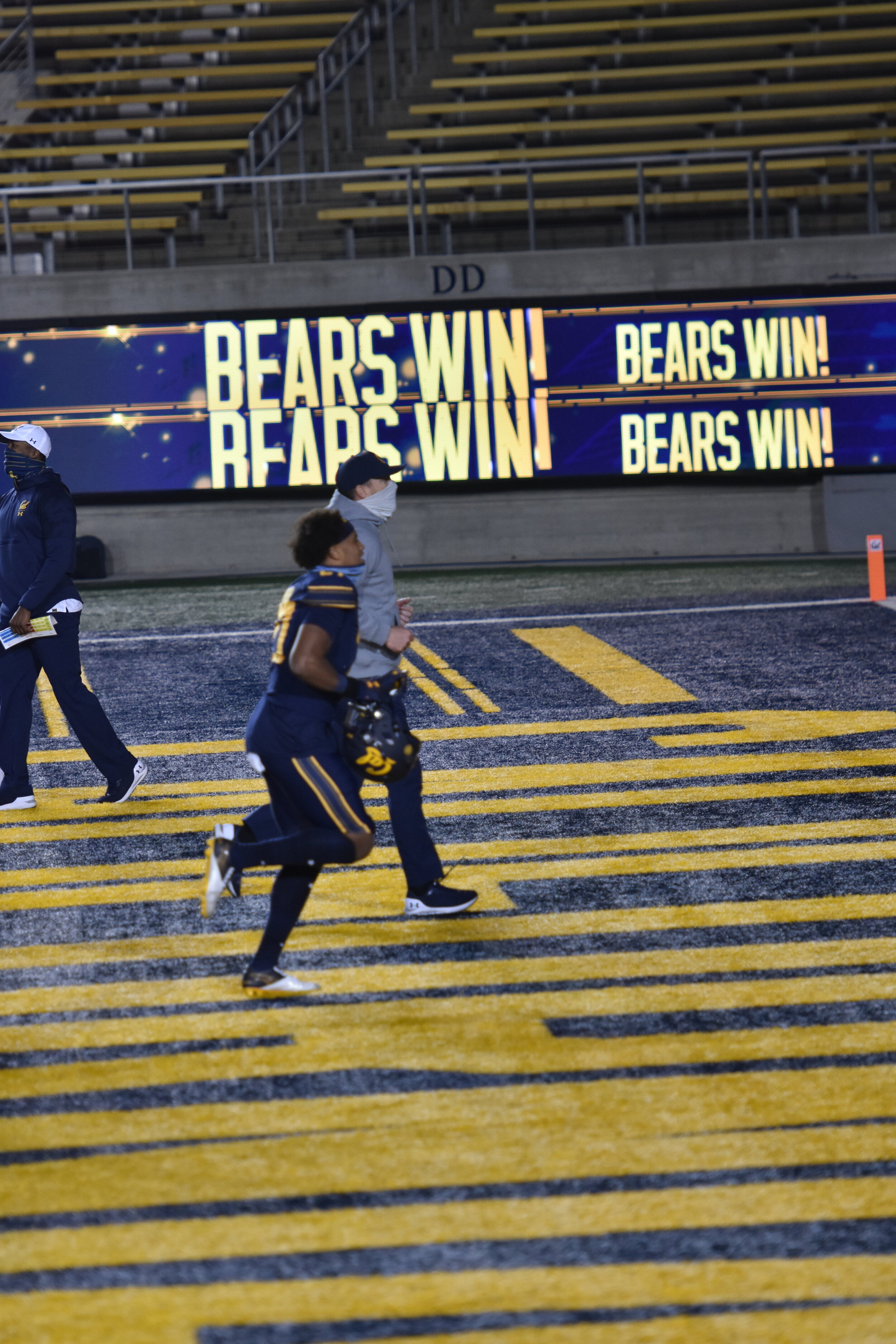
(Photos by Section925’s Connor Buestad)
Read this awesome feature on new Warriors guard Nico Mannion by Chris Ballard
/Four years from now, if all goes as planned, Nico Mannion will be on your TV, playing for a big-time college basketball program, like UCLA or Duke or Kentucky. He’ll lead the offense fearlessly, rain deep jumpers and regularly dunk on fools. He’ll also own a bazillion free pairs of shoes, eat Oreos whenever he wants and have, like, a hundred thousand followers on Instagram. He might even have a girlfriend, though he’s not totally sure about that part yet.
And after that? Well, after that the future gets awfully big. The NBA? The face of a shoe company? His own bobblehead, complete with a poof of red hair? Yes, it’s all possible. After all, when Nico was in middle school, his youth coach watched him skittering around the court and zipping passes, and declared that if you want to see what an NBA lottery pick looks like, well, there you go, and he’d point at the tiny, goofy-looking pale kid, all elbows and ears, who couldn’t weigh more than a wet golden retriever. And of course this was a ridiculous and unfair amount of pressure to put on a 13-year-old, because as any parent knows, extrapolation is an inexact science when it comes to human beings. Many a towering seventh-grader becomes an average-sized adult, and just because little Judy is good at math now doesn’t mean she won’t end up working the night shift at IHOP.
(NY Times) What I Learned Inside the N.B.A Bubble
/By Sam Anderson
The moment I entered Walt Disney World, I felt extremely sad. I was driving alone in a hypersanitized rental car, wearing two masks and a pair of disposable gloves, with all the windows rolled down to blast out any lingering virus. Florida’s atmosphere was gushing in all over, swamping me with its jungly breath. The dashboard thermometer said 100 degrees. The freeway took me past multiple theme parks — SeaWorld and Universal Studios and a Bible-based attraction called The Holy Land Experience. At one point, I passed a fake volcano. Billboards advertised gun shows and hospitals and lawyers and Botox.
And then there they were: Mickey and Minnie Mouse, standing on either side of the road, making white-gloved gestures of welcome. A grand arch promised, in looping cursive script, that I had reached the place “Where Dreams Come True.”
Disney World, in normal times, is a sealed kingdom of childish joy. It promises frictionless fun to anyone who can afford the entrance fee. I had been there earlier this year with my family and, against my will, I loved it.
But now I was alone. Florida was a raging pandemic hot spot. The airplane to Orlando was nearly empty, as was the airport itself. For six months, my soul had been clenched in a fist of worry. I had stopped exercising and lost much of my hair; one of the arms of my glasses had snapped in half, but I never got them fixed, so now they tilted at crazy angles on my face. Disney World’s cheerful entrance felt like an exit for a road that had been closed for decades — the route to an old American fantasy that had permanently expired.
“We’re more than just a product” - The story behind Justin Forsett's new personal hygiene brand Hustle Clean
/By Connor Buestad | Connor@Section925.com
As a sophomore in high school in Mulberry, Florida, a tiny town of 3,000 people far outside of Tampa, five-foot-nothing Justin Forsett had no idea what UC Berkeley was, or brand management for that matter, or consumer behavior, or kale salad or Peet’s Coffee. He hadn’t read Friday Night Lights, or taken a public speaking class, or even dreamed about leading a relief effort in a hurricane ravaged town in Puerto Rico. He had NFL hopes like every other kid who gets picked in the first three rounds of PE football, but for a person of his stature, even those visions seemed faint. The one piece of clarity that Forsett had at that age, however, was that he was going to take advantage of every opportunity that was thrown his way. He hasn’t said no since.
“Hmm, safely? Safely, I’d have to say I’ve received over 1,000 ‘no’s’ since I started my business,” explains Forsett with a chuckle. “You’d be surprised how tough it is to raise money, to keep the business going, to push through. The goalposts are always moving. Nothing comes easy when you start a business from scratch like we did with Hustle Clean. But you simply can’t take ‘no’ for an answer.”
Long before Forsett was confronted with the onslaught of ‘no’s’ that every entrepreneur has to wade through, the high school sophomore was ready to say yes to anything that even remotely sounded like it would improve his chances of maximizing his potential in life. The first faint knock from Opportunity came when he learned a family friend had a place for him to stay in Arlington, Texas, a football hotbed that also offered an academically focused high school that could put Forsett on a path to a Division I scholarship. It didn’t take long for him to say yes and pack his bags, leaving his comfortable and familiar life in Florida behind, seeking something new, with the confidence that it would lead to something great. As cliché as it sounds, he literally never looked back.
When he stepped foot on the small campus of Grace Prep Academy in Texas, Forsett ran wild, wasting no time putting himself on major college coaches radars around the country. As the touchdowns piled up, Forsett was able to generate enough buzz around him to get an unofficial scholarship offer from Notre Dame. But at the last minute, the storied program for South Bend pulled the rug out from under Forsett and said no to him after all. They had secured a taller, higher rated running back at the last minute and Forsett was left standing when the music stopped.
“At that point, I really had nowhere to play in college, as crazy as that sounds. It was getting really late in the recruiting process, so I sent my game tape to all the schools out west,” says Forsett. “Fortunately Cal responded. Next thing you know, I’m on campus in Berkeley.”
Forsett tallied 27 touchdowns in his four year career at Cal before realizing his NFL dreams. (photo by Jed Jacobsohn)
Thousands of miles from his family in Florida and Texas, and perhaps even further away if you consider the gap in culture and politics, Forsett adapted seamlessly. You couldn’t have blamed him if he had his excuses. The huge campus in Berkeley could not have been more different than his quaint campus in Texas and the curriculum on his plate was anything but easy. Add to that the fact that Marsahwn Lynch entered Cal’s program the very same year, playing the very same position. Nothing was going to come easy for Forsett when he chose to accept Jeff Tedford’s offer to come to Cal. But if you get to know Forsett, it’s no surprise he didn’t shrink from the challenge.
In fact, it was in the locker room with his football teammates where Forsett’s entrepreneurial gears first started turning. Their locker room talk consisted of new ideas that they could turn into a business, which lead to what is now Hustle Clean, a brand that sells disposable body and face wipes that substitute for a shower, as well as other personal care products that are still in the pipeline.
“It’s a running joke that you hear a lot in locker rooms, especially in football. A guy won’t have time to take a shower because he’s late for class or something, so he’ll say ‘hey fellas, I’m just gonna take a shower pill and call it good.’ Well, we went ahead and actually made a real shower pill, which was an antibacterial, moisturizing body wipe,” explains Forsett.
Forsett himself could have used a few “shower pills” during college, when you consider how many classes he was rushing out the door for. Unlike your stereotypical power five conference athlete who might put school on the backburner to focus on playing football in front of millions of viewers on Saturdays, Forsett was developing a growing interest in advertising and marketing concepts and ideas that were foreign to him just a few years prior. If Cal was going to teach it, Forsett was going to take advantage of it. And he wasn’t going to hesitate to apply it to his own creative business ideas.
By the time Forsett was a senior in Berkeley, the 5’8” running back finally had the backfield all to himself as Lynch gave up his senior year to start his career in the NFL. Cal fans were understandably worried about losing that much production from a superstar running back, but Forsett silenced the doubters with a senior season of 15 touchdowns. By the time he left campus in the spring of 2007, he had squeezed out everything Berkeley had to offer him. He left with an NFL opportunity in one hand and a start-up business plan in his back pocket.
“Cal was an incredible experience for me. I’m so thankful to all my professors and coaches that I came in contact with out there. They delivered on their promise of opportunity and I tried to meet them halfway. It worked out well for both of us I’d say.”
Forsett and Kap in 2014 (Photo by Rob Carr)
If there is a common thread that runs through Forsett’s life, it’s that for every opportunity that he capitalizes on, a new form of adversity quickly emerges, eagerly awaiting to test him yet again. The NFL, or better yet the “Not For Long” league, was just that.
There are “only” seven rounds in the NFL draft and Forsett had to wait till the seventh to be picked in the 2008 draft. Once he got into the NFL, he was “fired” as he likes to say, six times. He played for seven teams in the league, bouncing from city to city, having to prove himself over and over again, never complaining or feeling sorry for himself. After all, he was in the NFL, a childhood dream. He’d figure out how to make it work.
By 2014 he made the Pro Bowl as the Baltimore Ravens starting running back. That same year, Shower Pill (which has now been rebranded as Hustle Clean) was first launched commercially.
By 2016, Forsett decided to hang up his cleats and focus on not only his business, but his wife (former Cal/ National Team volleyball player Angie Pressey) and their four children. Two years later, he found himself with his two business partners on national TV in front of Mark Cuban and the rest of the Shark Tank crew, pitching their body wipe product for the world to see. Although the sharks withheld an investment offer, the experience on the show and others like Good Morning America helped Shower Pill’s revenue grow to new heights.
True to form, Forsett has refused to rest on his laurels since Shower Pill’s uptick in success two years ago. In fact, he and his business partner, Wale Forrester, recently decided to makeover the company entirely, leaving consumers in the personal hygiene space with a brand they can more identify with. A brand that can not only sell wipes for you body and face, but can also roll out a stable of personal care products under the same name.
“A couple years back, I was doing sideline reporting with the Baltimore Ravens. I was on the road to Cincinnati to do a game and it just hit me. Our company is at the intersection of hustle and hygiene. Hustle Clean!” explains Forsett with a huge smile on his face.
Our 'Fresh' scent that you all know and love is back and coming SOON to a @Target near you! pic.twitter.com/RCkVoCEW9o
— Hustle Clean (@HustleClean) July 13, 2020
Thus, the current name was born and just last month, the new branding was brought to market with a video you can find below. In it, you can see the passion and love that Forsett has for the brand that he created. A brand that he wants to cultivate into something that goes far beyond just a 10-pack of body wipes for $9.99.
Over the past few years, when disaster has struck communities not just in America but around the world, Forsett and his team have been on the ground helping those people in areas where there is a water crisis. Forsett understands that a body wipe might not solve all the problems that a hurricane victim is facing, but the instant hygiene provided to them can bring them the dignity to help get them through the day.
“Honestly, for me it is more important to serve and leave a lasting impact in this world then anything else. We were in Flint, Michigan following their water cris, in Puerto Rico after Hurricane Maria, we even partnered with a hospital to send our products to help with wound care in Uganda. It’s a great feeling to see the faces of the people you help. I want to do more of that.”
After visiting with Justin Forsett for an extended period of time, it is hard not to come away newly motivated and inspired, even during a global pandemic. His message in 2020 has little to do with the fascinating tales of NFL glory or pitching a business idea on national television or putting his locker room idea from college into a tangible product that can be found at your local Target store. Instead, Forsett makes it clear that his intent is to help others above all else. A mission that he couldn’t fully fulfill out on the football field, but has gotten closer with a body wipe.
“I want to encourage people to continue to dream. It’s not enough for me to make it to the NFL, then go on with my life and sit back and consume. My whole goal was never to just be an all pro football player. I wanted to be an all pro husband, an all pro father and an all pro business man.”
Will “All Pro Football Player” already checked off the list, Forsett has just a few more items left to tend to. Even if you don’t invest your money with him, just make sure not to bet against him. He just might prove you wrong.
The Forsett family at their home in Texas
Oakland's Tyson Ross bringing "Loyal To My Soil" Baseball Camp to West Oakland
/Courtesy of CoachingCorps.org
By Connor Buestad | Connor@Section925.com
On Friday, January 22nd, Oakland native Tyson Ross will be bringing a full day of professional level baseball instruction to Bay Area youth, free of charge. The first annual “Loyal To My Soil” Elite Baseball Camp will take place at Oakland’s Raimondi Park and will be committed to serving roughly 50 inner city high school baseball players as well as accompanied parents and coaches.
Ross, who played his high school baseball in East Oakland at Bishop O’Dowd before starring at Cal and pitching for both the A’s and Giants, is partnering with CoachingCorps.org to get the camp off the ground and keep it going for years to come. Ross’ stated goal for the camp is to unify the local community and revitalize baseball in under resourced black and brown baseball programs in and around Oakland. Local professional players and coaches are expected to attend the camp and give back both their technical knowledge of the game to local players as well has share general life wisdom with everyone in attendance.
Along with general baseball skills training, the camp will feature mental skills coaching, Sparta Science Force Plate Scans, college recruitment advice, mentorship opportunities, and guest speaker seminars from top names in the game of baseball.
Now with ten years under his belt as a Big Leaguer, including over 900 innings logged on the mound, Ross is looking to do everything he can to help promote baseball in the city where he first fell in love with the game. He will be doing exactly that to help ring in the new year before heading off to yet another Spring Training Camp of his own.
Ross pitching for his hometown team.
Sec925 Podcast Ep. 213 - Taelor Lewis on the NBA's return
/Good friend of the pod Taelor Lewis joins Connor to give her thoughts on the NBA’s restart amidst a global pandemic.
Patty Mills is donating all of his NBA restart money ($1M) to social justice organizations
/Good on you, @Patty_Mills. pic.twitter.com/7knxfIrJLt
— San Antonio Spurs (@spurs) July 8, 2020
By Connor Buestad | Connor@Section925.com
The NBA plans to come back into our lives on July 30th via a bubble in Orlando, Florida. Saint Mary’s College legend Patrick Mills is set to make $1,017,818.54 over the last 8 games of his regular season playing for the San Antonio Spurs and he announced on Wednesday that he’ll be donating ever cent of that money to social justice organizations that he feels worthy. These include “Black Lives in Custody,” “Black Lives Matter Australia,” and a campaign titled “We Got You” which is dedicated to ending racism in sport in Australia.
Starting in 2007, Mills played two seasons in Moraga for the Gaels of SMC before turning pro. His fabled number 13 was retired at McKeon Pavilion in 2015. It now hangs in the rafters next to Tom Meschery’s number 31 and Matthew Dellavedova’s number 4.
Oakland’s Darrell Adams Junior’s path leads him to the doorstep of the NFL
/Adams’ durability and raw athleticism has caused many NFL scouts to take notice leading up to the 2020 Draft (Photo by Section925)
By Connor Buestad | Connor@Section925.com
The last time Darrell Adams Jr. cried on a football field was not for the reasons you might envision. It wasn’t after receiving a bone-rattling hit in Pop Warner as a pre-teen, indoctrinating him into the tough culture of Oakland football. It wasn’t after falling short in an unexpected playoff run for Stellar Prep High School in Hayward. And it wasn’t after saying goodbye to his four year football family at Azusa Pacific University outside of Los Angeles. The last time Adams broke down emotionally on a football field was when he simply wasn’t allowed to play.
At age 16, Adams was in his first few weeks at Stellar Prep, having just transferred over from Foothill High in Pleasanton to play his junior year for a new coach; a new opportunity. From the stands there would have been no way to tell that Adams was suffering to the point of tears. Built like a Greek god even before he received his driver’s license, Adams roamed the sideline on this particular Friday night with his usual stout and intimidating stature, wide and chiseled shoulders supporting a proud lion-like face, chin up and assured, watching his new teammates enjoy another night of high school football without him.
Maybe the only person to witness Adams shed a tear that night was his head coach Desmond Gumbs. Everyone else was either too afraid to admit what they saw, or too surprised to believe it. Certainly nobody on the sideline was going to address it. Even at that age Adams carried himself like a football warrior, and if he needed to shed a tear on the gridiron, it said nothing about his level of toughness, which was too obvious to debate.
“I looked down the sideline and was shocked to see him crying,” explains Coach Gumbs. “He had his head in the game, he had his uniform on, and he was fully supporting his teammates. But still, he couldn’t play. I know that was excruciating for me to see him go through that. It must have been even tougher for someone that young to deal with it, but he did it. His head up the whole time, focused on the game in front of him. I knew he was special for having that attitude so young.”
---
Adams chose APU over ASU and Utah out of Stellar Prep HS in Hayward (Photo courtesy of Azusa Pacific University)
It wouldn’t be a stretch to say that Darrell Adams Jr. was born to play football. His dad Darrell Senior starred at Oakland Tech as a running back, paving the way for the likes of Marshawn Lynch behind him. His mom carried more than her fair share of the athletic gene herself. The result was a kid with a football body you could only conjure up in a lab. “I have two sisters and they pursued careers outside of sports, so yeah, I guess you could say I’m the athlete of the family,” explains a smiling Adams at a recent pre-draft workout.
Inquire about Adams’ athletic abilities with his college coaches and you get a direct response every time.
“If you’re asking me why he’s a draft prospect, one reason is that he’s an athletic specimen, why don’t we just start there?” Azusa Pacific head coach Rudy Carlton tells me sternly. “The first time I saw him I thought he was an outside linebacker, then he lines up and runs a 4.5 in the 40 and catches the ball all over the field. Those numbers speak for themselves.”
Despite the blessings of a body built for the rigors of NFL Sundays, Adams’ childhood was often consumed with change and challenging circumstances that drew him far from a football field, tasked with more important family business to tend to. The only constant in his middle school years was change, constantly moving to different neighborhoods in Oakland and the greater East Bay as his family searched for a consistent home. The rent in the notoriously expensive Bay Area was never easy to come by and a home invasion only added to the adversity. But the biggest challenge above all for Adams was helping his mother Latasha beat her daily battle with lung disease.
“For as long as I can remember, I have been taking care of my mom. Her and I are incredibly close and she is really a big inspiration for my football career in general. When I was younger, I might have lost some time playing football to care for her, but in the end it was obviously worth it. She’s a huge part of my life,” says Adams.
Adams’ high school career started at Foothill High in Pleasanton where his mother was living at the time and by his sophomore year he was already starting on varsity at wideout. Surrounded by a supporting cast who had Division I aspirations themselves, Adams began to prove himself as a college prospect, earning invites to offseason camps across the state. Camps that ultimately shape his future in the football world.
Following Adams’ sophomore season at Foothill, he and his mom packed up their car with her oxygen tank that supported her lungs along with Darrell’s cleats and drove to any high school football showcase camps they could find. The Elite 11 Camp where Josh Rosen was throwing? Pack up the car and let’s go. Rivals Camp down south featuring the likes of Najee Harris? Sign me up. If there was a big-time camp in the state of California, Darrell and his mom were going to be there, looking to get his name on the map. Hungry to play as much as possible.
It was on this camp circuit that Adams was introduced to Stellar Prep-Hayward head coach Desmond Gumbs. Although Adams was there to be seen by college coaches he also had plans of moving back to Alameda County for family reasons, and Gumbs was all ears.
Adams didn’t ultimately make the decision to transfer from Foothill to Stellar Prep until the middle of August at the start of his junior year, a week after he had played in a seemingly harmless scrimmage. Little did he know his participation in that one scrimmage would disqualify him from playing at a new school for the rest of the year.
“At first I thought the league was going to let me play after five games. That was initially the deal. But eventually they said I was done for the whole season. I missed my whole junior year, which was devastating,” says Adams.
The evangelical Christian Azusa Pacific University was a perfect fit for Adams’ devout principles. (Photo courtesy of APU)
So there he was, a rising senior with big dreams of playing major college football, but there was just one problem: He had zero game tape from his junior year.
Adams spent little time wallowing in sorrow and instead devised a plan to hit the football camp circuit yet again, determined to be seen by someone out there who could give him a chance beyond high school. The athleticism was obvious but his exposure remained minimal.
Back out on the road they went, him and his mom, running down a dream, literally. Once even driving to San Diego for a one day camp and then turning around and driving back, right after its conclusion. Wherever there was a chance to be seen, Adams was going to find a way there. And eventually, it worked.
Coming off a year standing on the sidelines of a small private school in Hayward, Adams now had offers from Arizona State and Utah. Both of which came after seeing Darrell play for less than one full day.
“Let me be clear, this does not happen!” explains coach Gumbs. “Power 5 programs don’t just show up and give out scholarship offers on the first day they see a kid play. But when they saw Darrell do his thing, they went for it and I don’t blame them.”
Yet as much as the bright lights and PAC-12 TV cameras called Darrell’s name, his desire to stick to playing wide receiver and becoming a featured playmaker was ultimately what he wanted most. Enter Azusa Pacific and Coach Victor Santa Cruz. The head coach at the time, Santa Cruz won over Adams with a home visit for the ages. Pulling into the Adams residence driving a sleek “APU SUV,” Santa Cruz made sure the drive up from LA was worth it, ultimately convincing Adams that his talents would be best utilized in his up and coming D-II program. Darrell couldn’t say no to the opportunity to play. At small Stellar Prep High he played every down, even Special Teams. At APU, Adams would get similar star treatment.
In his first year playing for Azusa, he helped take the team to their first NCAA playoff trip in program history and in his four year career he solidified himself as a go-to reciever at the college level. By the time his college career was complete, he had compiled a career of consistency and durability that no one can argue with. A résumé that now has NFL scouts tracking down his cell phone number expressing interest in drafting him this weekend, albeit over a Zoom call.
Now that Adams is knocking on the door of an NFL dream, it is easy to forget how recently he was just a high school kid with no game tape, a few dreams and loads of athleticism. Fast forward to today and you see a man with a newly minted degree in Criminal Justice to go along with a 40 time that even Nick Saban or Bill Belichick would gawk at.
Roger Goodell won’t be calling Darrell Adams Junior’s name on ESPN tonight on Day 1 of the NFL Draft, but this is of no concern to Adams himself. All he’s ever bargained for is a chance to get out on the field and prove he can compete with the big boys and he has complete faith an NFL team will put that opportunity in front of him sooner than later. Don’t be surprised if he snatches it out of thin air. It’s rare that he sees an opportunity he hasn’t been able to run down.
HBO's documentary "The Scheme" explains in detail how business is done in Major College Basketball
/By Connor Buestad | Connor@Section925.com
Directed by Pat Kondelis, HBO’s new documentary titled “The Scheme” tells (former) basketball agent Christian Dawkins’ side of the 2017 college basketball corruption scandal investigated by the FBI. The two-hour doc is very well-made, engaging and entertaining, giving the viewer a unique perspective of how the bribery business of college basketball gets done. Certainly, it seems impossible for Dawkins to be as innocent of all wrongdoing as he is portrayed in the film, but that doesn’t mean Dawkins isn’t a great narrator for even a better story.
Dawkins’ business model of how to profit off high school and college basketball players is ultimately simple. First, do the research of what players have a legitimate shot of being a first-round pick in the NBA Draft, pay said players to help them out financially and win over their loyalty, then represent those players as their agent when it comes time for them to be paid millions by the NBA.
Of course, this agency business isn’t exactly the most honest line of work, but Dawkins doesn’t seem to mind. He hates everything the NCAA stands for and has no problem breaking all their rules to profit from holes in their system.
The film highlights how the FBI used gobs of taxpayer money to expose the fraud in College Basketball, but ultimately did a sloppy job of achieving their goal, resorting to the arrests of low hanging fruit and watching the big fish swim away scot free. In the end, the investigation does a solid job of exposing College Basketball for what it currently is (a cutthroat, big money business) and a poor job fixing the problem in any tangible way for the future.
Perhaps the most fascinating section of the film comes toward the end when two big time college coaches, LSU’s Will Wade and Arizona’s Sean Miller, are caught speaking with Dawkins on FBI wiretapped phone calls. Both Wade and Miller have vehemently denied any association with Dawkins during “how-dare-you-question-me” type press conferences on their campuses. Yet, here they were on the phone with Dawkins, clearly talking about how much it costs to get players to come play for their schools.
“Do you think you’ll get Naz Reid?” Dawkins asks Miller over a wiretapped phone. Naz Reid being a 5-start recruit in his senior season at a New Jersey high school. “No, he’s going to LSU,” explains Miller. “He’s not even visiting us, that’s all bullshit. All that fucking hype shit on the phone, it’s stupid. He just probably said ‘you know what, fuck you I don’t want 75(k) I want 120(k), I may go to Arizona.’ That’s all that was,” says Miller.
“We could compensate him better than the rookie minimum,” Wade tells Dawkins over the phone discussing a different player, laughing. “We’d give him more than the D-League.” Wade moves to another player with the following quote, “What do you think? ‘Cause I went to him with a fucking strong ass offer about a month ago. Fucking strong. I’ve made deals for as good a players as him that were fucking a lot simpler than this.”
Any credibility that you may have held onto for LSU or Arizona basketball flies straight out the window when you hear these conversations straight from the mouths of the coaches themselves. Laughably, the head coaches discussing these payments to players still happily hold their multi-million dollar jobs, while the assistant coaches below them face criminal charges.
In the end, it’s hard to trust anyone’s side of the story in this riveting documentary, whether you’re talking about the coaches, the agents, the lawyers or even the filmmaker. The more you learn about any side, the more you realize you still have yet to learn. Just about the only thing you can fully trust in the “The Scheme” is the wiretapped conversations. And thank god they’re there, because with a story that has this many twists and turns, it’s nice to have something to hold onto that you know is real.
Arizona Wildcats coach Sean Miller has at least 9 lives.
A March Retrospective - Looking Back at the Last 60+ Years of Cal Basketball
/Jason Kidd battling LSU in the first round of the 1993 NCAA Tournament.
By Connor Buestad | Connor@Section925.com
Well somehow we got through March 2020. The 31 gutwrenching days are behind us. We are left with the economy nearly in shambles, our government in disarray, our families getting sick, and our sports stripped from our televisions. We needed the joyful madness of college basketball in the worst way this March. The only thing that could truly ease the pain of a virtual lockdown of the world was a collection of buzzer beaters and One Shining Moment. But instead, we were forced to trudge through March Sadness 2020 with nothing but heartache and awful statistics from the CDC of what lies ahead. So, in the name of reflection of what once was and what could have been, why not look back at the last 60+ years of Cal basketball and the Bears’ triumphs in the month of March?
This might take a while, so let’s get some sobering stats out of the way early. Since Pete Newell turned in his whistle in 1960, the California Golden Bears have been to the Big Dance just 14 times. On seven of those trips, Cal came home with a first-round tourney victory and on two of those trips they made a magical run to the Sweet Sixteen. Yes, Cal has made some deep runs in the NIT and even won the whole thing in 1999, but much like the Cheez-It Bowl, we aren’t here to discuss that. We are here to relive Cal’s true glory days.
Pete Newell Sets the Bar High
Now before we dive into the highs and lows of Cal’s (modern-era) past, we owe it to the Old Blues to at least make mention of World War II Era hoops in Berkeley. When WWII kicked off in 1939, the NCAA had just held their first proper basketball tournament six months prior, pitting the Oregon Ducks against THE Ohio State University Buckeyes. Not surprisingly, the Pac-12 school came out victorious.
During that time, the great Nibs Price was roaming the sidelines for the Bears. Nibs had a lot on his coaching plate to be honest. Not only did he coach Cal basketball for 30 years from 1924 to 1954, but he also coached the Cal football team from 1926 to 1930. Suffice it to say, Nibs was Cal Athletics.
But in his 30 years guiding the Bears basketball program, only once did he make the NCAA tournament, which resulted in a 52-35 semifinal loss to Oklahoma A&M in 1946. Cleary, we were still multiple decades away from an idea of a three-point line at that point, but we were already in the dunking era of basketball! Yes, a 7-foot white dude named Bob Kurland on Oklahoma A&M “accidently” began dunking in the mid-40’s. Dick Vitale would have lost his shit if he were there to see it. Instead, nobody seemed to care. Fundamentals ruled the day in the 40’s.
At the end of the 1954 season, Nibs finally gave up the reins of the Cal program to a guy named Pete Newell who ended up doing pretty well for himself. Newell had just finished two four-year stints at USF and Michigan State before he took the Cal job. After his first year going 9-16, Newell quickly made the Bears into a perennial winner. He ended his career at Cal going to the tournament four years in a row and in 1959 he won the whole damn thing, beating Oscar Robertson’s Cincinnati Bearcats in the Final Four and Jerry West’s West Virginia Mountaineers in the National Title. Ah, Cal athletics in the 1950’s. Trips to the Rose Bowl and basketball National Championships. What a time.
Pete Newell and his players pose with the 1959 National Championship Trophy after beating Oscar Robinson and then Jerry West.
Lou Campanelli Brings Cal Back to Relevancy
After back-to-back trips to the Natty, Coach Newell had seen enough and moved on. This lead to the Dark Ages of Cal basketball. No seriously, it was dark. Cal was suddenly average/bad for 25 solid years after Pete Newell. First it was Rene Herrerias, then Jim Padgett, then Dick Edwards, then finally Dick Kuchen. No matter who the coach was, the 60’s, 70’s and 80’s were a dry time to be a Cal hoops fan. Bone dry.
But then came Sweet Lou Campanelli through the door, yelling at whatever happened to be in his way. In his first year, he won more games in Berkeley (19) than any coach had since Coach Newell. The next year, he got the Bears to 20 wins with Kevin Johnson at the point and by 1990 he had the Bears back in the NCAA Tournament for the first time in (gulp) 30 years! He rode guys like Keith Smith, Brian Hendrick and Roy Fisher to a 22 win season, culminating with an historic first round victory of Bobby Knight’s Indiana Hoosiers. Two years earlier, Knight had won the National Championship at Indiana and in 1990 he had superstar Calbert Cheaney in his backcourt, but it still wasn’t enough to hold off the sturdy Golden Bears from winning a 65-63 battle.
That 1990 triumph over peak Bobby Knight would prove to be the high-water mark of Coach Campanelli’s career, but controversy and scandal was still on the horizon.
Ah yes, the 1992-1993 Cal Basketball season. With all due respect to Pete Newell’s 1959 National Championship run, this has to be the most memorable year in Cal hoops history. You know the story, but it’s too good not to touch on it one more time. Campanelli brings on a young, fast talking, self-assured assistant coach named Todd Bozeman to help him recruit with the big boys of college basketball. It works exactly as planned, as Bozeman manages to convince Lamond Murray, Jason Kidd, Alfred Grigsby, Monty Buckley and Jerod Haase all to come to UC Berkeley to play basketball, none of which had any clue who Pete Newell was.
We later learn that Bozeman literally took a “by any means necessary” approach to recruiting, but that’s neither here nor there for the interest of this story. The fact is, Cal all of a sudden had some true ballers out of the Harmon Gym floor, thanks in large part to Bozeman.
Of course, Kidd caught fire as a freshman and instantly turned Cal basketball into the hottest ticket in town. Fans flocked to Harmon in record numbers to see the show and were subsequently shocked when Coach Campanelli was fired 17 games into the season. Bozeman, just 29-years-old at the time, moved over one seat on the bench and led the Bears on a six-game winning streak to end the regular season and head into the Big Dance.
There, the Bears came from behind to beat LSU in Round 1 of the tournament, setting up a matchup with the vaunted Duke Blue Devils, two-time defending National Champions featuring Grant Hill and Bobby Hurley. Using a 28-point performance from Lamond Murray, a 14 assist effort from Jason Kidd and 13 points off the bench from Jerod Haase, the Bears shocked the world and sent Coach K packing for home much earlier than he was used to. The Sports Illustrated cover shot from that game can only be described using one word: iconic.
Coach K had no answer for J Kidd.
A Story Too Good to be True?
In the Sweet Sixteen, Bozeman’s magic would eventually run out, losing to Rex Walters and the Kansas Jayhawks. But what could go wrong now? Cal’s recruiting prospects were suddenly brighter than ever, Bozeman was officially the full-time head coach, and Kidd and Murray were coming back for another year. The stars were finally aligning for Cal basketball.
Not so fast, my friends. In classic Cal fashion, the wheels fell off quickly and dramatically.
The 1994 Cal basketball season started with the Bears ranked #6 in the nation. Let that sink in for a second. The Bears finished the regular season going 22-7 heading into a matchup with the University of Wisconsin-Green Bay. Cal somehow lost by four. Dick Bennett celebrated with his Green Bay underdogs as Bozeman all but ripped off his tie and stormed off the floor in disbelief. It was a sign of upsetting things to come.
With Kidd off to the NBA, the Bears suffered through a losing season in ‘95, even with the addition of high school All-Americans Jelani Gardner and Tremaine Fowlkes. Unfortunately for Bozeman, it was later revealed that he paid Jelani Gardner a pretty penny to choose Cal over the other college basketball blue bloods.
1996 was Bozeman’s last hurrah and it was a fun one, while it lasted. Shareef Abdur-Rahim arrived on the scene and averaged 21 points as a freshman. Ed Gray transferred to Cal from a Junior College in Idaho and put up 16 a game. Randy Duck was raining from three consistently. Tony Gonzalez was throwing his weight around in the paint. Jelani Gardner was still getting PAID. Yes, it was really fun while it lasted. The Bears bowed out early in the tournament that year to Iowa State. Bozeman was canned at the end of the year and the NCAA made Cal vacate their ’96 tournament appearance. So maybe just act like you didn’t read the paragraph you just read. Moving right along.
Ben Braun Leads Cal into Haas Pavilion
Enter Ben Braun. An opportunistic coach who led the Bears through 12 seasons, including the renovation from Harmon Gym into Haas Pavilion. Braun inherited a scary-good team in his first year in Berkeley and he didn’t screw it up. Ed Gray was a senior on a mission, averaging 25 points a game. Sean Marks began showing his NBA potential, as did Michael “Yogi” Stewart. Randy Duck was Randy Duck. Alfred Grigsby and Tony Gonzalez were both upperclassman at this point. The Bears were effing good.
Ed Gray kept Harmon Gym rocking like the old days.
They didn’t earn a ranking until finally hitting the Top 25 in late February, but Braun had his boys playing with a chip on their shoulder. The result was Cal’s second trip to the Sweet 16 in the 90’s, as they outlasted the Princeton offense and beat Villanova as well, to set up a battle with juggernaut North Carolina in the Carrier Dome. UNC would win that game and make it all the way to the national title with names like Vince Carter, Antawn Jamison, Shammond Williams, Serge Zwikker and Ed Cota on their roster. Without diving into the game tape too deeply, it's safe to say Ben Braun had no chance versus Dean Smith on this night. A great run it was, regardless.
A year later, the cupboard was bare for Coach Braun. Almost everyone from the Sweet 16 team was gone. Sean Lampley was just a freshman and Geno Carlisle wasn’t exactly Ed Gray. Cal basketball was back to normalcy again. Bruan would have to wait until Lampley was a senior until the Bears would be back in the Dance.
Now in the newly renovated digs of Haas Pavilion, Braun led the Bears to three straight tournament appearances from ’01 to ’03. In 2002 and 2003, Braun used a clutch core of Joe Shipp, Amit Tamir and Brian Wethers to record first round tourney victories over the Penn Quakers and NC State Wolfpack. It wasn’t Duke or Villanova, but it was something.
Much like Bozeman, but without the scandal, Braun finally woke up to the fact that he had a wealth of basketball talent in his backyard and started to tap into it. This led him to his last tournament appearance as the Cal coach 2006. Leon Powe, Ayinde Ubaka, DeVon Hardin and Theo Robertson were all born and bred in the Bay Area. Braun didn’t let them slip away and brought them to Cal. This decision paid major dividends as the Bears kept their head above water in an ultra-competitive Pac-10. Almost everyone was good in the league at that time and Braun’s Bears were one of the best.
Monty Comes Back to College; Cuonzo Brings More Controversy
Despite Braun’s three trips to the tourney and one trip to the Sweet 16, by 2008 his career in Berkeley had run its course. Mike Montgomery was waiting in the wings and although he was a mess coaching the Warriors, we all knew he could get a Pac-12 school to win from his days on The Farm. Much like Braun, Monty inherited a talented team in his first season in 2009. Jerome Randle and Patrick Christopher were juniors now and ready to run. Jorge Gutierrez was a freshman. All the pieces were there and the Bears went dancing. A year later, they went again with the same core group, this time beating Louisville in the first round. Randle played all 40 minutes that night, and led the game in scoring along with Theo Robertson.
Jerome Randle electrified Cal fans with his ball handling wizardry.
After a year watching the tournament from home, the Bears reloaded with Allen Crabbe and Justin Cobbs to give Montgomery two more well deserved years in the tournament. In 2013 the Bears survived and advanced by beating UNLV in Round 1. Syracuse was too much in Round 2. Montgomery was gone a year later.
Cal’s last appearance in March Madness came to us via Cuonzo Martin, bringing us back full circle to a general theme of hope, controversy and heartache in Berkeley. Martin arrived on campus as a fresh, young, talented coach who had just come off a Sweet 16 run coaching at the University of Tennessee. Much like the Cal coaches before him, Martin inherited a very talented roster that included future NBA guards Tyrone Wallace and Jabari Bird, not to mention Jordan Mathews who would later lead Gonzaga to the National Championship Game. Also true to the Berkeley way, Martin hired a controversial assistant coach to help him acquire the best recruits in the nation in Yanni Hufnagel. Unlike Bozeman, Hufnagel never found himself coaching against Coach K in the Sweet 16, but he did find himself embroiled in a sexual harassment case that threatened the integrity of the athletic program. The more things change…
Hufnagel’s recruiting work brought local blue chip Ivan Rabb in from Bishop O’Dowd as well as Jaylen Brown all the way from Marietta, Georgia. Both of which wound up in the NBA after their time at Cal.
The high point of Rabb and Brown’s collegiate career figured to come in 2016 when they put together a 23-10 season heading into the tournament, then everything unraveled in an instant. The Hufnagel scandal broke the week of their first round game against Hawaii, Tyrone Wallace broke his hand in practice, and Jaylen Brown basically forgot to show up to the game, scoring just 4 points.
The bad taste of that loss to Hawaii still lingers for Cal fans four years later as we watch Jaylen Brown tear up the NBA night after night and Cuonzo Martin count his money in Missouri as a 10th place team in the SEC. The bitter taste wasn’t helped by Wyking Jones who produced back-to-back eight win seasons in Berkeley before mercifully being let go to again pursue his career in show business.
Ironically the last taste Bear fans had of Cal basketball this season was sweet victory over Stanford in an empty arena in Las Vegas earlier this March. As we sit in self-quarantine still licking our wounds from the unprecedented cancellation of March Madness, perhaps we can somehow imagine that Mark Fox would have somehow shocked the world and caught enough lightning in a bottle to send Cal through the Pac-12 tournament field and into the Big Dance for the 15th time since the Pete Newell Era. Likely? Of course not. A blow-out loss to #2 seed UCLA was more likely. But at this point, 40-minutes of live basketball in the month of March would do wonders for the soul. It doesn’t necessarily have to be Jason Kidd beating Duke. Anything would do, really.
Senior Kareem South vs. Stanford in 2020.
"Live from the Levi's Cheap Seats" - Sec925 takes in the first Niners playoff game in Santa Clara
/Photo by Jim Rowney (Section925)
By Jim Rowney | Section925 Correspondent
It was a long wait. Coming off a Super Bowl appearance and three consecutive NFC Championship Game appearances, both first time and long time 49er season ticket holders assumed the playoff appearances would continue in the 49ers sparkling new home in Santa Clara. A rash of injuries, along with infighting between the GM and coach, turned 2014 into a season of mediocrity. A series of retirements by key 49er veterans, some questionable coaching decisions, and even more injuries, made the 49ers an afterthought in the NFL postseason for five forgettable years.
The large crowds and initial excitement in those early 2014 games at Levi’s became a memory. Add in new stadium teething problems in the first several years, and Levi’s got the reputation as a giant boondoggle. Home field advantage? Hardly, when opposing fans made up a healthy percentage of the crowd, with large swaths of empty seats. One popular sports radio host called it the “worst of the new NFL stadiums, and it’s not even close”. There were even yearnings for Candlestick (where my wife once missed an entire quarter to go to the restroom and buy me a beer).
Was it the stadium, the location, or the poor on-field performance by the home team that caused such emotions? Probably a combination of all those things. But things have changed. Continued work on the stadium and infrastructure brought viable improvements. Food vendor variety and quality was improved, stadium employees became more experienced, and cellular access is now excellent. Traffic patterns were diagnosed and changes made. The VTA figured out how to move people in and out with their excellent light rail system. How many times have people used the word “excellent” in reference to a Bay Area transit agency?
Simultaneously, a new GM and coach seemed to be making all the right moves. Jimmy G arrived, along with a force of nature named George Kittle. A pass rush that made even the unflappable Aaron Rodgers look uncomfortable. Suddenly, long suffering Levi’s season ticket holders are on their way to an NFL Divisional Playoff game at Levi’s Stadium.
Count my family and I among those loyal season ticket holders. We attended the last game at Candlestick, the first at Levi’s, and Saturday’s playoff game, the first of its kind. Indeed, we do occupy the cheap seats, high up in section 405, where the field is small, but so is the Personal Seat License price tag, and views are uninterrupted. We also get a decent breeze from the bay in the hot months, sparing us from the well documented heat of the lower bowl.
Following our usual game-day pattern, we parked at one of several free lots near a VTA light rail station, where an express train whisks us to Levi’s in about 15 minutes. We have driven and parked at the stadium a few times, but $50 is painful, especially when compared to the $5 round trip VTA ticket. Remember we are in the cheap seats!
The train was full (stuffed might be a better word) after just a few stops, and the occupants festive. Viking fans were heartily booed when trying to enter our full car…and yes, they were rejected. The weather…well it reminds of us why we live in the Bay Area, and put up with our traffic and housing issues. Perhaps a little cool for locals, but downright balmy for visitors from Minnesota. Daytime football, like God intended, on a splendid winter day…a combination even Viking and 49er fans could agree on.
90 minutes before kickoff, the tailgating was in full force. Walking thru the predominately red and gold parking lot was fun, people were loud and friendly. However, to be honest, nothing will ever replace the sights and sounds in the Oakland Coliseum parking lot before a Raider game. The imagination used in various interpretations of what constitutes a “Raider” will be sorely missed.
Levi’s was never an attractive stadium from the outside, lacking symmetry and classic architecture forms. But somehow, draped in huge banners, surrounded by the buzzing crowd, it seemed to rise up to the moment.
My experience with Levi’s 49er fans, at least regular season fans, is mixed. Notoriously late arriving, there are also a fair number of what I call posers. Splendidly maxed out in 49er colors, jerseys, and accessories, their main concern during the game is attending to vital social media issues, or trooping up and down the stairs between their seats and the bar, eventually staying there after halftime. Saturday seemed very different. The huge crowd was in their seats before kickoff, and for the first time that I remember, extremely few (if any) empty seat in our section. Perhaps it was the price of admission, or the importance of the game, but it was great to see. Viking fans were relatively sparse, but not silent, at least in the first half. We had one in front of us…we liked him because he looked like a Viking, complete with horned hat and long white beard. A good sport also; lacking opportunities for high fiving fellow fans, especially in the second half, he joined us for some friendly hand slapping.
Loud? Yes. Levi’s was finally rocking. On the Vikings first possession, the chants of “DE-FENSE!” rang out with intensity. “Aye-OO’s” were loud and coordinated after every 49er first down. I had the opportunity to attend the Clemson-Alabama National Championship game a year ago at Levi’s, and although the fans were also loud, they were split close to 50-50. The Alabama half of the stadium was deathly silent most of the game. Not so this Saturday. It’s fair to say the 49ers have finally found, and earned, a home field advantage.
There will be plenty of words written about the game itself, so I won’t review it. It was, however, an interesting throwback day for the NFL. Both winners, the 49ers and Titans, brought to mind sayings like “Defense wins championships” and “The game is won at the line of scrimmage”. Old time football! At least for a day, spread offenses and read-option quarterbacks took a back seat.
Leaving the stadium the crowd was happy, but strangely quiet. Perhaps exhausted from the outpouring of energy. Most of the talk concerned who the 49ers would likely play, or who they wanted the 49ers to play. Frankly, I was just happy and satisfied that my season tickets finally paid the dividend I was waiting for, and that we would be back in just 8 days. The verdict for Levi’s Stadium? Not bad at all, far better than the detractors have claimed. Once inside, it doesn’t matter much what it looks like from the outside. The concourses are wide, facilities numerous, and sight lines are good; even better when you are seeing a football team as good as the 2019-2020 San Francisco 49ers.
Kyle Blanks saw MLB’s opioid issues first hand, now he’s on a mission to help alleviate the problem
/By Connor Buestad | Connor@Section925.com
It’s real easy to be intimidated by Kyle Blanks.
Google him, and you’ll find a 6’6” man built from 265 pounds of seemingly solid muscle. Raised in a small town in New Mexico, Blanks’ hobbies over the last decade included getting new tattoos and punishing baseballs with a huge barrell in Big League ballparks throughout America. By all accounts, from his last name, to his oversized #88 jersey, Blanks comes across as a badass you don’t want to f-ck with. Not unless you are equipped with a 98 mile-per-hour fastball that you could somehow throw by him.
From 2009 to 2015, Blanks stuck in the Majors as a reliable power threat for the Padres, A’s and Rangers. Riddled by the injury bug, he finished his career with 33 homers, not to mention countless homers on nondescript fields on his path to The Show. He even went deep on Tyler Skaggs once. By the time his time in baseball was over, Blanks was a bona-fide Big Leaguer with the numbers to prove it.
Refreshingly, especially in 2019, the big ego that often accompanies an athlete of Blanks’ stature is nowhere to be found when you speak at length with the gentle giant. Although he looks back fondly at his long career in baseball with pride, Blanks has successfully transitioned to a new chapter in his life with a new mission. He has no interest in reminding you how good at baseball he once was. Nor does he need to explain how many homers he might have hit if his luck with injuries was better. He’s completely past all that “bullshit.” “It’s simple. I just want to help out as many people as I can,” he explains.
Much different from your typical ballplayer, Blanks is blessed with a level of intellect, curiosity and compassion that is very real when you move past his baseball card and understand him as a person. He’s serious when he says he wants to help others and make a difference; his cause is an alarming issue he sees across baseball and professional sports. Increasingly, players are turning to the use of opioids to fend off the pain of injury and stress during a long season. In the case of Angels pitcher Tyler Skaggs, the issue of pain relieving drugs cost him his life this past season. Blanks maintains it’s an issue that runs far deeper than a one-off event in a hotel room on a road trip. “These drugs are more common than you think. More available than you think. It’s just like any other workplace, these players are human with issues they are fighting through like anyone else. We are talking about a small sample of people, but even this small group is definitely affected by our country’s opioid problem,” explains Blanks.
The MLB and the players’ association plan to re-evaluate their drug policy in the wake of the autopsy report last week on Tyler Skaggs, the Los Angeles Angels pitcher who had fentanyl, oxycodone and alcohol in his system when he was found dead in Julyhttps://t.co/VZZZgnyCCw
— The New York Times (@nytimes) September 8, 2019
Not only is Blanks passionate about talking on the issue of opioids in pro sports, he is also taking steps in his career after baseball to create solutions for people to deal with pain in safer ways. As Chief Operating Officer of Road Runner CBD in New Mexico, Blanks is helping to create cannabis products that can be used to relieve pain in much safer ways than even the mildest dose of an opioid could.
Ironically, Blanks was forbidden to use cannabis products for the majority of his career as a pro athlete. While in Major League Baseball, cannabis use was legal, but heavily frowned upon. In the minors, where most players spend a huge chunk of their careers, it was completely illegal and tested for often. Blanks, who was often sidelined with injuries during his time in the minors, was left with alcohol and pills as his options to regulate his pain from injury and overall wear and tear from late-night games and all night bus trips. “I don’t care who you are, we all need something to help us wind down from our day. Some people require more than others. Some people’s days are more taxing than others. What players are using to regulate their injuries and their sleep patterns are often not safe at all,” says Blanks.
Part of Blanks’ humility and sense of his place in the world comes from his humble upbringing in a small town on the outskirts of Albuquerque called Moriarty, New Mexico. Despite his imposing frame and devastating strength, Blanks’ bat went relatively unnoticed by MLB or D1 scouts in high school, leading him to take his chances at Yavapai College to prove himself at the junior college level. Even with his success at Yavapai, pro scouts were willing to wait for 41 rounds to pass before using the 1,241st pick in the 2004 draft on Blanks.
When you’re a 42nd rounder in baseball, nobody’s going to hand you anything. The organization has a minimal investment in you and if you can’t hit for two weeks, you might get a handshake and a bus ticket back home to where you came from. Fast. Instead, Blanks faced the long odds in front of him with a zen-like, day-by-day approach and hit himself to the highest level. A Staph infection in 2006 was Blanks’ first big battle on the injured list. Little did he know when he made the San Diego Padres roster, his body would really start to fall apart.
Blanks is now a co-owner of Road Runner CBD, based out of New Mexico (Photo via PressReader.com)
In his rookie year, he suffered a plantar fascia tear in his right foot. The next year he underwent Tommy John surgery on his throwing arm. Two years later, he tore his labrum in his left shoulder, then in 2014 he was getting injections to treat an achilles injuries in both feet. The next year, a cyst removal, not to mention arthroscopic surgery in both of his heels to shave bone and remove tissue. His last season included another achilles operation.
“It was never ending,” explains Blanks when discussing his laundry list of injuries. “I was in the trainer’s room constantly. Always working with the medical staff, always rehabbing. I don’t want to compare myself to him, but I see where Andrew Luck was coming from. These injuries and this rehab is hard for anyone.”
Anytime these professional athletes limp off the field, the time is ticking for them to get back on it. Especially for Blanks, a 42nd rounder who had to prove his worth every time he stepped on the field. If you miss a week in baseball, you miss six games. That’s 30 at-bats.
Blanks defends all of the trainers and medical staffs that he came across in professional baseball. They never crossed the line, never handed out a pill that wasn’t well intentioned. They were always acting in the player’s best interest. But that doesn’t take away from the fact of how powerful these pain pills really are. In many cases, they’re opioids, and they can be dangerous. One pill too many, and you just might not wake up.
“I’m not out here trying to blame anyone in particular, but I’m trying to let people know that these pills are in the game. They might come with good intentions, but they are still dangerous. There are better ways to treat pain and the leagues should be open to those options,” says Blanks.
When Blanks talks about his playing days in Major League Baseball, he doesn’t talk much about the home runs he hit, or the hotels he stayed in, or the Hall-of-Fame pitchers he faced. He talks about the pain. The day to day struggle of getting through a 162-game season with a busted up body. The nights drinking and taking pills, trying to find a way to get through the night, knowing that no one wants to hear a millionaire in his 20’s complain about playing baseball for a living.
“There’s not much difference between me and Skaggs when you think about it,” explains Blanks. “I always woke up and drove to the ballpark. Unfortunately Skaggs didn’t that day. This is a bigger issue than people like to admit. Hopefully we can do something about it. I’m motivated to do my part.”
(Photo by Kelvin Kuo / USA Today)
The Oakland Roots bring professional soccer to Oakland
/(Photo by Robert Edwards - KLC Fotos)
Hoping to fill the void a new professional soccer team in the East Bay, the Oakland Roots are attempting to win the heart of the Oakland community through a strong branding and marketing campaign that emphasizes its deep ties to the city. The Roots debuted this Saturday evening at Laney College in the newly minted National Independent Soccer Association. Their first opponent was the California United Strikers.
Deadspin weighs in on Jay-Z's partnership with Goodell and the NFL
/Photo: Ben Hider (AP)
By Billy Haisley (Deadspin.com)
It’s safe to say Jay-Z, to some extent, takes cues from Colin Kaepernick. Jay-Z has expressed his admiration of the former quarterback before, once calling him an “iconic figure.” In the aftermath of Kaepernick’s black-balling from the NFL for his peaceful protest of police killing unarmed black men, Jay-Z rejected the league’s offer to have him perform at the Super Bowl in solidarity. And in a disappointing though unsurprising turn of events, Jay-Z has once again followed Kaepernick’s lead by selling himself and the things he represents to a soulless corporation that will use him to sell things.
Yesterday, the NFL announced that it had bought off Jay-Z’s once-seemingly resolute antagonism toward it by reaching an extensive, and presumably quite lucrative, partnership agreement with Jay-Z’s company, Roc Nation. The partnership’s aim is “to enhance the NFL’s live game experiences and to amplify the league’s social justice efforts.” This will include Roc Nation taking the lead on wrangling entertainers to perform at events like the Super Bowl, hopefully saving the NFL from the storm of controversy it endured ahead of the last Super Bowl, when Jay-Z and several other high-profile musical acts snubbed the NFL out of support for Kaepernick, as well as various audio initiatives linking artists whose brands are in part built around projecting an image of sociopolitical-mindfulness and players, who, according to the New York Times, might put together some playlists or podcasts. The revolution may not be televised, but it apparently will be conveniently streamed to your smart phone for you to listen to on your commute to work.
